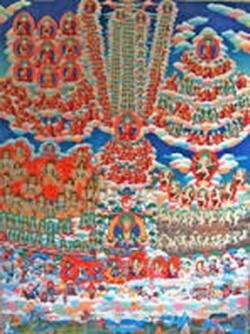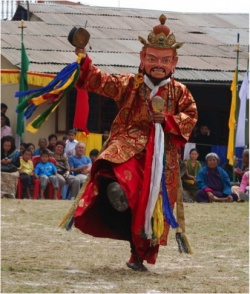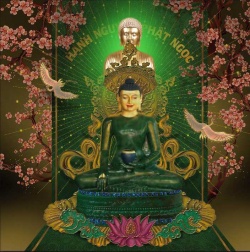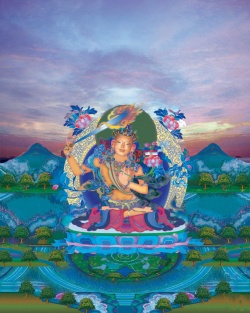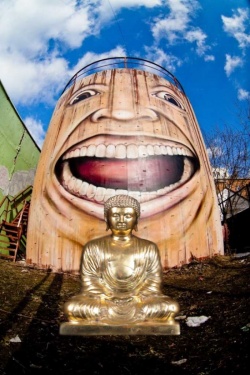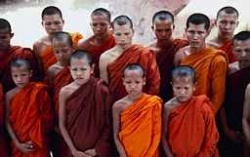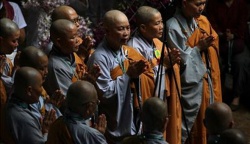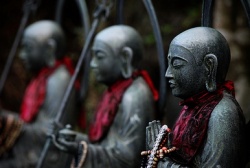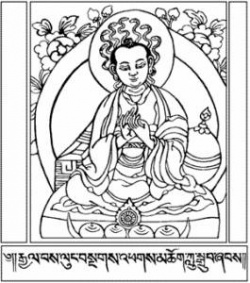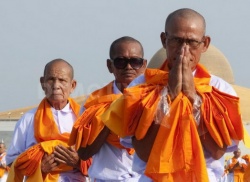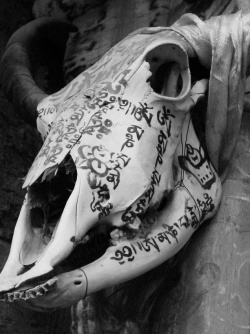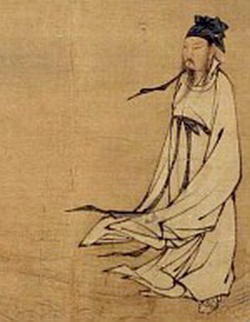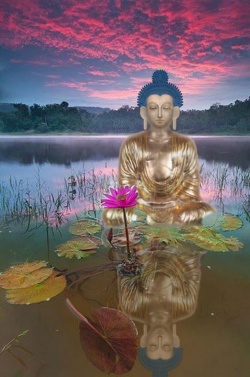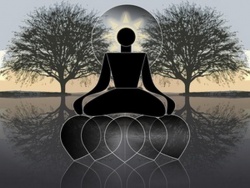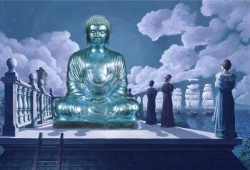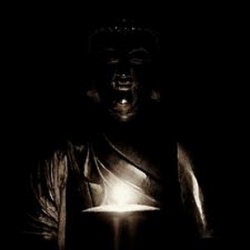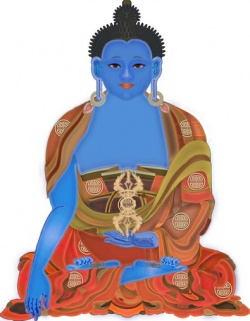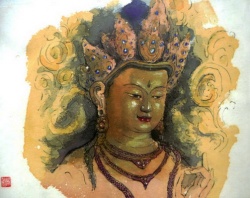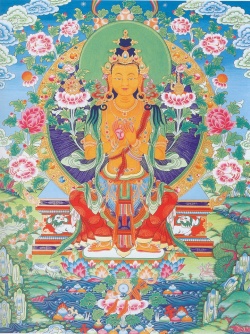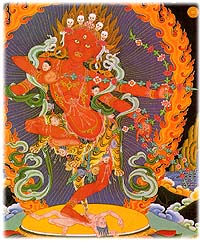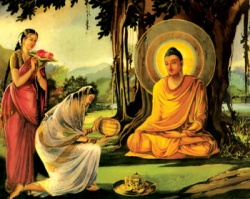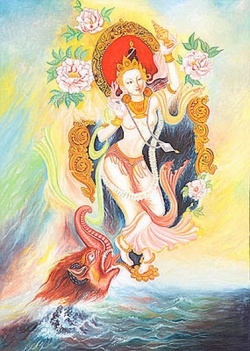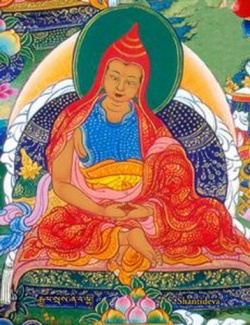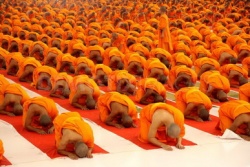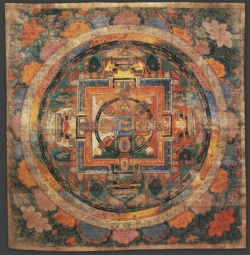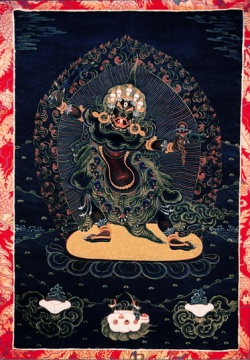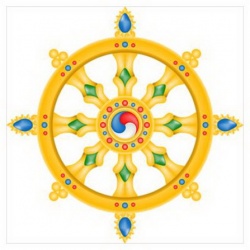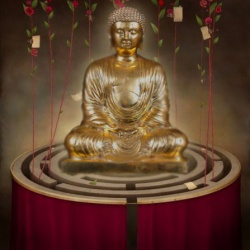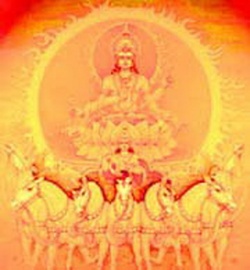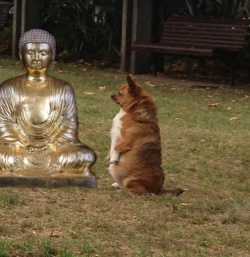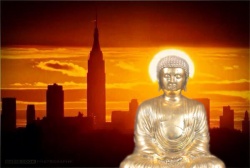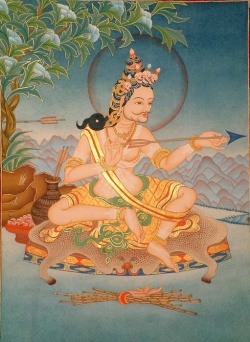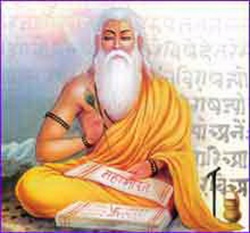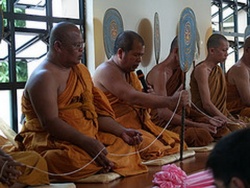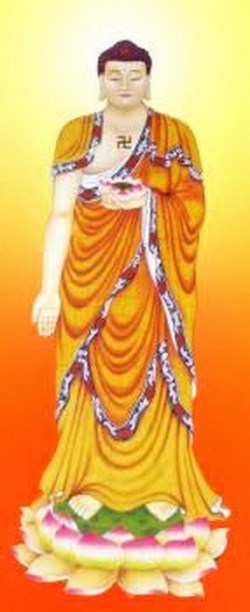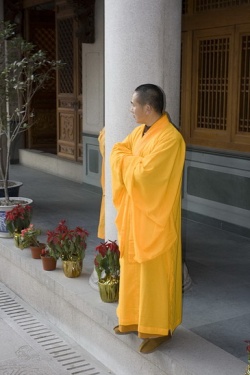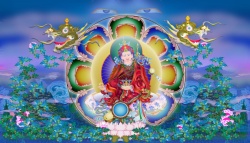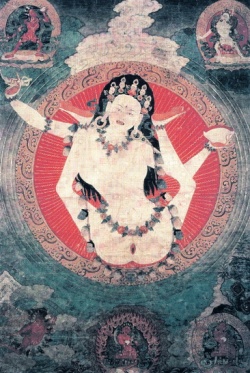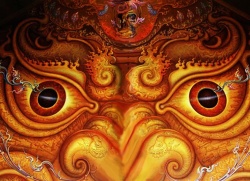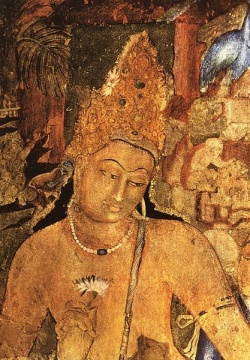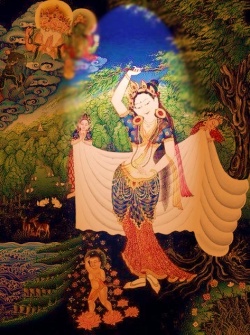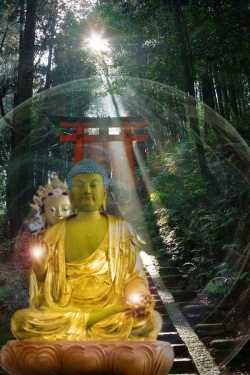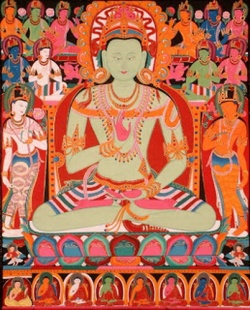The True Origins of Psychology and the Influence of Euro-American Ethnocentrism by Robert Espiau
The True Origins of Psychology and the Influence of
Euro-American Ethnocentrism
by
Robert Espiau
30 December 2013
© 2013 Robert Espiau
All rights reserved
Contents
- 1 Abstract
- 2 Dedication
- 3 Chapter IIntroduction
- 4 Chapter IILiterature Review
- 4.1 Introduction
- 4.2 The Ethnocentric History of Psychology
- 4.3 Psychology Originated in India, not in Greece
- 4.4 Importing Psychoanalysis to India
- 4.5 Brief Background of the Schools of Teaching Within Buddhist Psychology
- 4.6 Non-Western Models of Self That Have Been Discounted and Overlooked
- 4.7 Structural Examples of Psychological Theories Taught by Buddha
- 4.8 Summary
- 5 Chapter IIIComparative Analysis: Decolonizing Buddhist Practice
- 5.1 Introduction
- 5.2 Buddhist Meditation Practice: Learning to Know Without the Intellect
- 5.3 The Foundations of Buddhist Meditation: Samatha and Vipassana
- 5.3.1 Jhana meditation: right concentration
- 5.3.2 The eight jhanas
- 5.3.2.1 Access concentration
- 5.3.2.2 First jhana: Ecstasy or rapture
- 5.3.2.3 Second jhana: Joy
- 5.3.2.4 Third jhana: Contentment
- 5.3.2.5 Fourth jhana: Equanimity
- 5.3.2.6 Fifth jhana: The sphere of infinite space
- 5.3.2.7 Sixth jhana: The sphere of infinite consciousness
- 5.3.2.8 Seventh jhana: The base of no-thingness
- 5.3.2.9 Eighth jhana: The base of neither perception nor nonperception
- 5.4 What Is Lost in Translation
- 5.5 Renovating Buddhism: The Filter of Euro-American Ethnocentrism
- 5.6 Samatha Vipassana as a Psychological Tool
- 5.7 The Discipline of Psychology: East and West
- 6 Chapter IVConclusion
- 7 References
- 8 Source
Abstract
This paper explores evidence that Euro-Western designs of psychology are founded on a model that is culturally biased, failing in historical references and textbooks to acknowledge and give credit to earlier teachings of psychology from Eastern religions. The history of Euro-Western cultural bias in the development of the field of psychology has led to the exploitive importation of Buddhist practices without recognition or adequate understanding of Buddhist psychological theory. The author spent 6 years as a monastic and over 23 years teaching and practicing samatha and vipassana forms of meditation. Using ethnographic and hermeneutic research methodologies, this thesis demonstrates that Buddhist theory constitutes the historical origins of psychology, containing teachings that predate, yet parallel, modern Western psychology. This research also contributes to a discussion of the value of decolonizing Western approaches to psychology and understanding Buddha’s psychological theory as it pertains to meditation and mindfulness practices.
Dedication
To my wife Keiko, who has supported me from the very beginning in all my explorations of the nature of consciousness. An inspiring woman who made great sacrifices in order for me to write this. An extraordinary woman who raised our son while I wrote this. I love her with all my heart and she is the reason this was made possible. And to Siavash, without him I would never had even considered becoming a psychotherapist. He showed me the real meaning of empathic attunement with others.
Chapter I
Introduction
Area of Interest
Western academic psychology is a discipline that has historically ignored profound investigations into consciousness accomplished by other cultures. The vast majority of Western textbooks on the history of psychology make no acknowledgment of other cultural views of psychology outside of the Europeans and the Greeks (Benjamin, 2009; Goodwin, 2005; Notterman, 1997; Reed, 1997). Current histories of psychology that are widely available imply that, until the research and writings of German psychologists Gustov Fechner and Wilhelm Wudnt in the late 1800s, psychology was not considered a science and therefore did not exist as psychology (Leahey, 1987, p. 88). As a practicing Buddhist, trained in non-Western monasteries, I was dismayed to discover that students of psychology have been expected to accept that psychology did not exist until Fechner showed how the mind–body relationship could be quantified in 1850 (Wilber, 2000, p. 8).
This paper explores the evidence that Euro-Western designs of psychology are based upon a model that is culturally biased. It is not biased simply because its origins are from the West, it is biased because it fails to give credit to the earliest teachings of psychology found in Eastern religions, even though Euro-American psychology is currently exploiting those teachings. Is the whole world really meant to accept Euro-American cultural history of psychology as being objective or true even though it excludes vast psychological systems within Buddhism and Hinduism?
This thesis also explores the Euro-American view that all learning and psychological development takes place within the brain and involves thinking, a cultural and ethnocentric psychological viewpoint that is being gradually imposed upon the world (Watters, 2010; Kim, Yang, & Hwang, 2006). Euro-Western science does not currently accept or acknowledge the existence of nonlocal consciousness. Further, research in the field of psychiatry and neurobiology has posited that consciousness, apart from the mechanisms of the brain, does not exist (Schwartz & Begley, 2002). Science therefore has the tendency through its reductionist approach to want to reduce all understanding to chemical processes occurring in the brain (pp. 21-52).
A society, such as America, that claims to be built upon multiculturalism and seeks to develop a more objective science, might need to recognize that there are other forms of learning that do not involve constant memorization and intellectual comparison. According to Buddhist psychological views, much of what we call knowing in this culture, ironically, keeps a person separated from consciousness. For the purposes of this thesis, I use the word consciousness to denote pure, naked awareness that exists apart from thought processes. Thought processes are herein defined as composed of conscious or unconscious symbols in the form of images or words. A new body of research called “unconscious thought theory” (Dijksterhuis & Nordgren, 2006, p. 95) supports this definition. In the Institute of Noetic Sciences (IONS) (2013) online database, over 80 years of hard research can be found that demonstrates the fundamental differences between Western views of knowledge and consciousness and Buddhist psychological models of learning; however, these differences seem to be largely ignored by psychological sciences in the West.
As someone who has lived and studied in traditional monastic settings in both America and abroad for nearly 20 years of my life, I have found psychological work in American culture to be much more superficial than the psychological work that one undergoes in monastic settings that require mindfulness and meditation training daily. Although my theoretical and practice orientation is primarily Buddhist, I also have had more positive than negative experiences in psychotherapy over the years and have appreciated the opportunity to learn Western psychological theory and practice. This has led me to wonder why my Western colleagues would show such ignorance and disrespect when it comes to appropriating strategies from Buddhist teachings in particular. It is, however, in keeping with the pervasive trend in the history of European and American colonization of disrespecting and dominating other peoples’ worldviews and systems of knowledge—to the point that over 220 million Native Americans have been killed, entire cultures and languages lost, and assimilation tactics seem normal to us (Kabat-Zinn, 2003). This horror can be seen equally at the British Museum or the Louvre in artifacts collected through a long history of dominating, exploiting, and assimilating other cultures.
My monastic training outside of North America, and particularly in India and Latin America, brought to my attention how mistrustful many of my teachers of Eastern psychology were of Western psychology. In fact, the majority of my teachers, including indigenous shamans in the amazon and my Zen master and lama, were against me pursuing a career in Western psychology.
There is an increasing trend toward integrating Buddhist practices in psychotherapy, with more and more Americans and Europeans attending meditation and mindfulness retreats, studying with Tibetan Lamas, frequenting programs at the growing number of ashrams in the West, or practicing yoga. However, it seems that far fewer foreign Zen masters, lamas, and yogis are seeking degrees in Western psychology. It has not been an equal exchange of interest and ideas. Trying to make sense of these differences, and of why Europeans and Americans would start charging large sums of money for teachings they received for free as part of the Buddhist practice of dharma, has interested me greatly enough to pursue this research.
In this thesis I am contending that it is an entirely Euro-American perspective that before Fechner, Wudnt, and Sigmund Freud, the father of psychoanalysis, psychology did not exist, but was philosophy. My contention in this critical research paper is that Euro-American psychology is highly ethnocentric. To study its history is to see that it has almost completely failed in its presumed scientific objectivity and is, instead, ethnocentric, subjective, and has been until the last 10 years, almost entirely racist (Guthrie, 1998). Even now, into the millennium, the vast majority of Euro-American academia fails to honestly acknowledge that historically, psychology by its original definition, and even as a pure science, existed before Euro-Americans defined it as such.
Guiding Purpose and Rationale
Why is the recognition of and comparative inquiry into a psychology that predates Western models so important? We are living in a time when the world is rapidly shrinking due to the information highway, cyber colonization, and the effects of globalization. Since the millennium, mindfulness and meditation are rapidly becoming the treatment in vogue. With the advent of more and more new therapies that include the practices of mindfulness in some form, it becomes important to acknowledge that Western psychology is now going full circle historically. We are returning back to the origins of psychological practices and teachings and taking from them. However, psychologists and researchers, adapting and exploiting psychological teachings that are over 2500 years old to create new therapies, are failing to acknowledge them historically as anything containing psychology.
That European and American psychological practice has been gravely ethnocentric in defining a healthy and unhealthy sense of self cannot be separated out from its presumptive claim to the origins of psychological science. Published theories of self, going all the way back to Freud and Carl Jung, the psychiatrist credited with founding analytical psychology, focus too narrowly on what is essentially Euro-American cultural experience. Americans comprise less than 5% of the world’s population (Arnett, 2008; Population Reference Bureau [PRB], 2012). The result is an understanding of psychology that is incomplete and that can neither adequately represent nor serve humanity.
The purpose of this thesis is to establish clearly a more objective historical understanding of psychological theory and practice as a human, cross-cultural endeavor; to deepen understanding of the psychological theory behind Buddhist interventions being adopted within Western psychological practice; and to support the development of a more culturally inclusive and astute body of psychological theory and practice. As a field dedicated, at least in part, to the understanding of consciousness and human nature, psychological theory and practice should, at a minimum, accurately attribute credit for its own development. As more and more clinicians look into the teachings of Buddhism, my hope is that they might consider that to use techniques without understanding or crediting the psychological insight and theoretical lens from which they arose is a form of cultural exploitation and colonization (Teo & Febbraro, 2003). Furthermore, it deprives the field of psychology of the opportunity to deepen and broaden its conceptualization of human nature, and limits the understanding and efficacy of the imported practices. This seems, in a discipline in which much is said about the development of the authentic self, a bold hypocrisy and violation of its own integrity.
Methodology
Research problem
In this paper I contend that psychology existed systematically long before Westerners cornered the market on it with their own special cultural terminologies. I use Buddhism as the main example, as many of its psychological teachings and methodologies are currently being extracted by and misrepresented within Euro-American psychology. Although research has demonstrated benefits to the use of meditation and mindfulness (Hanson, 2009; Institute of Noetic Science, 1997; Siegel, 2007), there are nonetheless strong waves of ethnocentrism at work in how Buddhism is being represented to validate Western uses of these technologies. I attempt to give the evidence that shows that Eastern psychology existed earlier than Greek philosophy and was more sophisticated. I also wish to present evidence that the view that Western psychological theory is superior and more objective is both ethnocentric and erroneous. How can American psychotherapists who believe that thoughts and consciousness are synonymous come to understand a psychological teaching in which the basis of learning is making the mind increasingly silent so as to separate thoughts, feelings, and body from awareness?
Research question
This thesis examines the following research question: Does the reductionist understanding of Buddhist teachings common in Western psychological practice devalue, underestimate, and leave out important information that could further serve human consciousness and the field of psychology? The process of researching the importation of ancient Buddhist practices into Western psychological practice raised additional questions: What psychological theory underpinning these practices has been, and continues to be, disregarded in the Western portrayal of psychology and its history? How can Eastern psychological perspectives help broaden the scope of Western psychology? What were Buddha’s actual methods for psychological investigation as opposed to Zen methods of meditation, Hindu methods, and Tantric methods? Why do Western psychotherapists often speak and write as if all meditation and mindfulness teachings are equal when within indigenous Buddhist theory and practice there are significant variations and differences? Comparatively, in the West, many systems of therapy involve active listening skills and reflective statements, yet have their implications and applications for the treatment of psychological problems differ from one another.
Methodological approach
This thesis is both ethnographic and hermeneutic in its methodological approach. It is traditionally hermeneutic in nature to the extent that it draws upon a comparison of Western and Buddhist philosophical and psychological writings. The hermeneutic research provides a foundation and support for the ethnographic study. Ethnography is the branch of anthropology and sociology that deals with the description of specific human cultures through qualitative social science research from an “insider’s point of view” (Hoey, 2102, para. 3). As I have spent over 6 years of my life living in monastic settings that utilized traditional forms of meditation for over 6 to 8 hours a day or more, I can safely say that these are cultures that practice these skills for a living. I have lived in Buddhist, Hindu, and Christian monasteries and have experienced first person what it means to practice mindfulness and meditation not just in a secularized form, but in cultural and psycho-spiritual contexts with a group of people whose cultural origins are Buddhist in nature and who are dedicated to experiencing states of deep mental silence.
- Ethnography may be defined as both a qualitative research process or method (one conducts an ethnography) and product (the outcome of this process is an ethnography) whose aim is cultural interpretation. The ethnographer goes beyond reporting events and details of experience. Specifically, he or she attempts to explain how these represent what we might call “webs of meaning.” (para. 2)
An ethnography attempts to follow an outline that includes a brief history of the culture in question and an analysis of the environment—in this case the psychological teachings of Buddhism and the monastery. I include some description of the social structure in which one usually learns such methodologies of consciousness, some detail in the special language spoken about meditation and meditative states of consciousness, and also some of the standard topics a Buddhist monk studies regarding perception through meditative technologies.
Ethical Concerns
My primary bias is that I am an American. I have grown up an American and as such, even though I have lived and studied meditation and mindfulness in other countries where culture and economics are different, I have the strong bias of growing up in a culture where we believe in individualism and self-esteem. I have grown up under these biases believing that individuals always have the right and the opportunity to make choices in their lives. I have not grown up in a culture where choice was the privilege of very few—where the values of fate, karma, or class systems hold dominance. This describes roughly two-thirds of the world. Until I had the opportunity to live abroad, I had no idea how other cultures view Americans. I had always identified with Western culture, having grown up with the adage, “America is the greatest country on earth,” not really considering that saying this means that other cultures are subpar or beneath our way of life and understanding.
It is not my intention in this thesis to idealize or romanticize Eastern teachings, East Indian or any other culture, as each has its psychological and cultural problems. Having spent time in India in order to study the six yogas of Naropa, I have experienced this firsthand. Neither do I claim to portray the perspective of someone raised in an Eastern culture. My concern is to contribute to research that seeks to respect and understand psychological discoveries, knowledge, and practices from other cultures.
Overview of Thesis
The literature review in Chapter II reviews literature that addressed the ethnocentricity of the history of Euro-American psychology, as well as Western psychological thought itself (Alvargonzález, 2013; Arnett, 2002, 2008; Brock, 2006; Cushman, 1995; Danziger, 1997; Kim et al., 2006; Teo & Febbraro, 2003; Watters, 2010). It provides a profile of the Buddha’s teaching, comparing his psychological constructs with those of modern Western theories, to show that the majority of the psychological teachings thought to be founded by Euro-Americans had already been presented by the Shakyamuni, or first, Buddha in the Pali canon over 2500 years ago, though credit is not given to the Buddha in any of the epic historical tomes of psychology available at the time of this thesis (Benjamin, 2009; Goodwin, 2005; Notterman, 1997; Reed, 1997).
Building on the foundational understanding provided in Chapter II, Chapter III relates, from my experience as a monastic, practitioner, and teacher, the Shakyamuni Buddha’s meditation process and discusses what is commonly lost in translation as Buddhist practices are assimilated into psychotherapeutic theory and practice. Chapter III offers an analysis of some of the new wave of books that are attempting to integrate Buddhist teachings with Euro-American psychology, showing that these writings are predominantly ethnocentric and largely inaccurate, and in stripping away cultural context, leave only the bias that Western values represent objective truths. As well, examples and suggestions are offered regarding how the Buddha’s original system of samatha vipassana could deepen and broaden the scope of American psychology. Chapter IV provides a brief summary of this thesis, discusses the implications of Buddhism for Western psychology, and makes recommendations for further study.
Globalization is affecting more than just the economies of the world; it is a new term that reflects not only the way in which money moves but also the way in which humans share resources, knowledge being one of them. In the quest for objectivity in psychology, scholars and clinicians alike should consider educating themselves as to how we look at the evolution of knowledge historically. It is unfortunate that in Western academia we have begun only recently to acknowledge the wisdom of Buddhist teachings as being on an equal footing with Euro-American psychology. If we are truly living in a multicultural paradigm, and are interested in sharing an objective view of knowledge, then we in the West must be also open to giving credit to cultures that have different methods of exploring knowledge, allowing ourselves, our theories, and our practices to be stretched and deepened beyond the scope of Euro-American views.
Chapter II
Literature Review
Introduction
Americans have often excluded the knowledge of other cultures because they do not practice science in the same form as that of the West. Because Westerners developed conceptions of empirical science, unfortunately Western science cannot be separated from cultural bias. This was demonstrated very elegantly in the writings of historical scholar Finn Fuglestad (2005) when he explained,
- Although history constitutes a western discourse, it professes nevertheless to be able to investigate the past of all societies and civilizations, and the whole of the past. It follows that we are entitled to expect from history a conceptual framework that is neutral from a culture-civilization point of view. But this is the problem, granted that the production of history involves . . . cultural practices. (p. 24)
In the last few years it appears in scholarly writings that many authors are willing to acknowledge Buddhist teachings as being worthy of examination. This chapter examines evidence that Buddhist teachings are actually the progenitors of psychology and that psychology existed amongst many cultures long before it became a part of Western scientific thought.
In modern Euro-American hard science, traditional Buddhist consciousness studies have been considered philosophical rather than psychological and scientific. Modern biological sciences in fact do not acknowledge that consciousness even exists (Schwartz & Begley, 2002). One of the world’s leading experts in neuroplasticity and pioneers in the field studying obsessive compulsive disorder, Jeffrey Schwartz and science columnist Sharon Begley, in their book The Mind and the Brain, explored the subject of consciousness in great detail, helping the student of psychology understand that consciousness does not have an agreed upon definition in the West nor is it recognized in the realm of biological science.
In the 21st century, more and more people are becoming concerned with the age-old question about what constitutes the self, the brain, and the mind. Schwartz and Begley (2002) cautioned that “more and more neuroscientists are admitting to doubts about the simplistic materialistic model” (p. 49). German neuroscientist Wolf Singer noted: “These elements of consciousness transcend the reach of reductionistic neurobiological explanation” (as cited in Schwartz & Begley, 2002, p. 49). In contrast, many indigenous cultures do see consciousness as something that exists and have formed their own technologies of science to verify and explore what consciousness (Kim et al., 2006). Buddhist models that greatly influenced Asian culture are an example explored later in this paper.
One of the first openly scientific acknowledgments of the potential of Buddhist psychological methods in investigating consciousness occurred in September of 2003 at the historical conference, “Investigating the Mind,” held at the Massachusetts Institute of Technology (M.I.T.) (Harrington & Zajonc, 2003). The conference was the first attempt at a dialogue and reconciliation between Western cognitive scientists and Buddhist psychological teachings. It was composed of Western scientists, The Dalai Lama, and other Buddhist psychologists. At the opening of the conference, the chairman of the Mind and Life Institute, Adam Engle, said,
- Science is the dominant paradigm in modern society for understanding the nature of reality and providing a knowledge base for improving people's lives.
Buddhism is a 2,500 year tradition focused on personal liberation, but liberation that is concerned to understand the nature of reality and use that understanding to overcome delusion. So it is the search for a better understanding of the nature of reality that forms the basis for our proposed dialogue between science and Buddhism. Buddhism uses the human mind, refined through meditative practice, as its primary instrument of investigation into the nature of reality. While this method of investigation is based on observation, very rigorous logic, and experimentation, scientists have traditionally viewed it as subjective and at odds with the objectivity of the scientific method. We believe science is wrong to reject such a mode of investigating the mind, and that there is much potential for fruitful exchange and even active collaborative research between scientists and Buddhists. This meeting has been organized to explore the wisdom and efficacy of this proposal. (As cited in Harrington & Zajonc, 2003, p. 4)
However, taking a step back from implementation of methodologies and engaging a comparative exploration of the psychological theory developed through the Buddhist approach to the study of mind and that of Western scientists raises the question of whether or not Buddhist methods and the theory behind them are being misrepresented. As discussed in the section below on the origins of psychology, as a science it began within Buddhism long before it was secularized and developed in the West (Johnson, 2002; Waldron, 2003; Wallace, 2006). American psychologists have recently begun drawing upon and creating psychological systems based upon 2500-year-old Buddhist methodologies. Currently there are at least four evidence-based psychological models that utilize Buddhist models of meditation and mindfulness: dialectical behavior therapy (DBT) (Linehan, 1993), mindfulness-based stress reduction (MBSR) (Kabat-Zinn, 2003), mindfulness-based cognitive therapy (MBCT) (Segal, Williams, & Teasdale, 2002), and acceptance and commitment therapy (ACT) (Hayes, Strosahl, & Wilson, 2003). Derived from distinctly non-Western theoretical ground with a completely different model of self, have Buddhist approaches been contorted by the process of grafting them onto Western theories?
Professor Thomas Teo of York University, Canadian scholar of the history and theory of psychology, and psychologist Angela Febrarro (2003), eloquently observed that
- hidden ethnocentrism is not overcome by simply assimilating ideas from other cultures, which would be a colonizing approach. In other words, a solution to hidden ethnocentrism requires a process of accommodation as well as assimilation. Euro-American human scientists must be willing to completely revise conceptualizations, if necessary, and not simply add to them. (p. 684)
How might recognizing the authentic differences broaden the Western understanding of consciousness and human nature? How might accommodation of other cultural views of psychological health inform those of us who work in the mental health field?
Such recognition and valuing of differences begins with a review of the literature related to the ethnocentric biases in the history of psychology and evidence of its pre-Western origins. A review of the literature that reveals basic Buddhist premises and of literature written by Western psychologists seeking to incorporate Buddhist practice provides a foundation for their comparative analysis.
The Ethnocentric History of Psychology
When examining the history of psychology it is interesting to note that “history is the product of the very past it purports to study. Hence history may be said to be the only academic discipline that is the product of its own object of study” (Fuglestad, 2005, p. 23). Thus it is the conquering or winning class that writes history.
In the Euro-American view, knowledge and psychology began with the ancient philosophies developed by the Greeks. In his paper on “Western Identity, Barbarians and the Inheritance of Greek Universalism,” European historian Helmut Heit (2005), professor of philosophy at the Berlin Institute of Technology, wrote extensively on the subject that he defined as Eurocentrism. Euro means “center” and Heit suggested that “ancient Greek thought has been used through the centuries to establish a superior Western identity of universal prevalence” (p. 1). This speaks to the kind of dominant and oppressive ethnocentrism through which Euro-American notions of epistemology have evolved. Mexican philosopher Enrique Dussel emphasized “that modern Eurocentrism confuses the global importance of western tradition and some of its historical achievements with a universal justification of these cultural features” (as cited in Heit, 2005, p. 728). The cultural features he spoke of included the free market, democracy, individualism, the right to determine one’s own destiny, and Euro-American scientific traditions that involve studying others from a position of objectivity.
In modern academic histories of psychology, such as From Soul to Mind (Reed, 1997), A History of Psychology (Benjamin, 2009), The Evolution of Psychology (Notterman, 1997), and A History of Modern Psychology (Goodwin, 2005), the authors have explained science, psychology, and philosophy as originating with Plato and Aristotle, eventually justifying the Whig approach to history that views later developments as superior to earlier ones. The Whig approach to history is one that seeks to emphasize the development of history relative to democratic liberties, Judeo-Christian values, and scientific progress, even at the expense of other peoples such as Native Americans (Alvargonzález, 2013). The Whig approach seeks to emphasize that the world could not have progressed and advanced without what has already passed—that no other alternative realities were possible, repressed, or need expression.
Historians of psychology, Edward Reed (1997), Ludy Benjamin (2009), Joseph Notterman (1997), and James Goodwin (2005), each portray advances as developing through Western philosophers until finally Fechner, Wundt, and Freud developed real psychology. In that psychology means “the study of the soul” (“Psychology,” 2013, def. 1), one can infer that at the turn of the century the progenitors of psychology as a field of study in the West saw their culturally biased observations of human nature and soul as synonymous. This Euro-American historical narrative, with its exclusion of the histories of racism and eugenics within 20th century psychology, has been rewritten again and again, emphasizing that all valuable origins of science come from the Greeks and reinforcing the Euro-American “identity of universal prevalence” (Heit, 2005, p. 1).
Professor of history at the University College Dublin, Ireland, Adrian Brock (2006) has spent the majority of his life studying other cultures and has tried to shine a bright light on the need to make psychology less American and less pharmaceutical. In his book Internationalizing the History of Psychology, he attempted to bring more clarity to cultural differences by having scholars from different countries share previously unknown views of psychology. Each scholar in this book, 13 in all including the author, examined the exclusion of the psychological models and discoveries of other cultures and the historical influence American and British colonization has had on this effect. Brock referred to three rules of “inclusion/exclusion in the history of psychology” (p. 3):
- The 1st rule is, If your work did not have a major impact on American psychology however influential it might have been elsewhere, it does not count. The 2nd rule is: If your work did have a major impact on American psychology, even though its influence was limited or nonexistent elsewhere, it is an important part of the history of psychology. The 3rd rule is: Asia, Africa, Latin America and Oceania do not exist. (pp. 3-5)
International journalist Ethan Watters (2010) wrote about the exportation of Euro-American ideas regarding what is mental health in his book, Crazy Like Us: The Globalization of the American Psyche. He discussed at length the bias spoken of by Brock (2006), a bias that led the pharmaceutical company Pfizer to sponsor a group of therapists to head down to Sri Lanka after the Tsunami in 2005. Pfizer was convinced that Sri Lankans were too naïve to understand the implications of posttraumatic stress disorder and that it could be very important and compassionate to make Zoloft available to treat symptoms. Ironically, for the last 2000 years Sri Lanka has been steeped in the Buddhist practices discussed in this thesis—practices that have only recently begun to be incorporated into Western psychological theory and methodology.
Pfizer’s strategy in Sri Lanka exemplified the way in which, especially with nontechnological cultures, Western Europeans and Americans have historically announced themselves as the originators of organized academics and other areas of science (Watters, 2010). From this perspective, Western scholarship sets itself up to be the standards for excellence in research and models of objectivity that study and reflect the psychology of humanity, not just a culture. The American Psychiatric Association (APA) recently opened its collective databases to cross-cultural studies with Divisions 26 (History of psychology) and 52 (International Psychology). However, professor of psychology Jeffery Arnett (2002), historian and psychologist Philip Cushman (1995), Brock (2006), and Watters (2010) called attention in their works to the ethnocentric and capitalistic values that seem to trump APA purported values of cultural competence and scientific objectivity as large pharmaceutical companies continue to export Euro-American views of mental illness abroad to boost sales of their products.
Arnett (2008), in his article, “The Neglected 95%: Why American Psychology Needs to be Less American,” demonstrated through examining 20 years of research presented in psychology journals that 95% of the psychological studies are done by Americans on Americans. Yet, “theories and principles are developed that are mistakenly assumed to apply to human beings in general; they are assumed to be universal” (p. 602). He also pointed out that as so little research has been done to understand the rest of the world, academic books used for university classes should not be titled Developmental Psychology or Abnormal Psychology, but rather should be entitled Euro-American Developmental Psychology or Abnormal American Psychology. These would be more accurate, less ethnocentric, titles that reflect the knowledge and research base. Brock (2006) commented that American textbooks are bought and circulated in universities abroad and that this has fueled part of the growing movement against American constructs of psychology and mental health, as other cultures are shocked to notice how they are excluded.
Psychology Originated in India, not in Greece
At the time Socrates (469-399 B.C.E.) was experimenting with logical argument as a way to prove what is true, in India the Upanishads had already been composed (600 to 300 B.C.E.) (Flood, 1996). The Upanishads gave an explanation about consciousness that is not clearly understandable to a culturally biased Western mind steeped in the belief that all knowing comes about through thought processes. Western academia looks upon the writings of Indian psychology as more akin to metaphysics than psychology because of the cultural need to separate psychology from any religious or indigenous views.
The Brihadaranyaka Upanishad, one of the older Upanishads contained within the Shatapatha Brahmana, includes teachings about the nature of consciousness and views on the nature of self. Upanishads like the Katha Upanishad teach what differentiates normal waking consciousness from the consciousness that takes place when one uses meditation methods to silence the mind (Flood,1996). The simple idea of meditation being a method to silence the mind and that stopping all internal thoughts and images is even possible is still a relatively new concept for Western psychologists to wrestle with. Even when there is now over 50 years of research into meditation (IONS, 1997), Western psychologists and anthropologists cannot allow for a cultural worldview that includes understanding aspects of reality without thought processes.
India is rife with teachings on the nature of consciousness and psychological technologies (Van Loon, 2003; Varier, 2005; Waldron, 2003). In fact, ancient Eastern alchemical texts played a decisive role in Jung’s formulation of the dynamics of the unconscious (Jaffẻ, 1968/1971). Jung (1929/1967) reported:
- Observations made in my practical work have opened out to me a quite new and unexpected approach to Eastern wisdom. In saying this I should like to emphasize that I did not have any knowledge, however inadequate, of Chinese philosophy as a starting point. On the contrary, when I began my career as a psychiatrist and psychotherapist, I was completely ignorant of Chinese philosophy, and only later did my professional experience show me that in my technique I had been unconsciously following that secret way which for centuries had been the preoccupation of the best minds of the East. This could be taken for a subjective fancy—which was one reason for my previous reluctance to publish anything on the subject—but Richard Wilhelm . . . gave me the courage to write about a Chinese text that belongs entirely to the mysterious shadowland of the Eastern mind. (p. 83)
Jung (1939/2000) also wrote a commentary that was included in the first English translation of the Tibetan Book of the Dead. In it he acknowledged how naïve the West has been to assume that because Jewish and Christian religious teachings do not contain sophisticated psychological teachings, neither do Eastern religions. In contrast to the either-or thinking regarding good and evil, and heaven and hell, of Western religious teachings, and the dualistic separation of religion and science in the West, in his commentary Jung appeared to stand in awe of how Buddhists came to the conclusion that both heaven, hell, and all possible after-death states are psychological, and that perception after death is based upon states of consciousness that were cultivated in life. How could people, presumed in the West to be primitive, have come up with this understanding? The following are various examples of psychological understanding that existed long before the development of the field of psychology in the West.
Ayurvedic medicine
Ayurvedic medicine is the comprehensive medical system indigenous to India that originated over 5,000 years ago (Prasad, 2013). Although Ayurveda is considered a form of complementary alternative medicine in the U.S., nearly 80% of the population of India uses it exclusively or in combination with conventional medicine. It is one of the oldest medical systems in the world, with eight branches of study, one of which is psychiatry and psychology. Defined as the science or knowledge of life, Ayurveda considers prevention of disease and promotion of mental health to be principal and the treatment of psychological and physical disorders to be secondary.
Ayurveda’s classical texts, such as the Charaka Samhita and the Sushruta Samhita, state that the mind (sattva), consciousness (atma), and body (sharir) comprise the foundations of life (Van Loon, 2003). Thousands of years before the arrival of modern psychology, Ayurvedic physicians had analyzed the nature, functions, phenomena, and conduct of the mind and consciousness in intricate detail. They described two broad aspects of consciousness: (1) the mind (manah or manas), defined as that which imparts, renders, and facilitates knowledge by use of the senses and reasoning, and (2) pure consciousness (buddhi), that, existing outside of judgments and evaluations, is unhindered by mental and emotional complexes and has the capacity to discriminate what is true without bias (Varier, 2005). Buddhi is a state of consciousness that can only be understood when the mind has become still and silent.
Classical Ayurveda details three principal attributes of mind, called the trigunas, and 16 major types of mental natures (manas prakruti), and discusses prenatal, perinatal, and postnatal factors that influence the development of these types (Varier, 2005). In addition, Ayurveda expounds upon various operations of the mind, including sensory perception, motor action, memory, contemplation, deliberation, reasoning, judgment, sense of self, sleep states, and dreaming. Ayurvedic teaching also expounds upon behavioral patterns that are learned, and the impact of various emotional states on the mind and body.
The teachings of the first Buddha
The Shravakayana view of Buddhist psychology follows the philosophy of empiricism that holds “that knowledge should be acquired through observation and experimentation” (Benjamin, 2009, p. 21). Socrates is said by scholars to have lived from 470 to 399 B.C.E. (Flood, 1996); yet given this time frame, if one examines the teachings within the Buddhist sutras, one can easily surmise that the psychological teachings of Socrates were not as well developed as those given by the Buddha in 500 B.C.E. nor that of the Upanishads in India. The teachings that are ascribed to the Shakyamuni Buddha include schematics on the nature of perception (Bodhi, 2000; Wallace, 2006), teachings on psychoanalysis (Bodhi, 2000; Dhammadharo, 1959/2010; Johnson, 2002; Waldron, 2003), and a profound discourse on cause and effect equal to Newton’s later theories (Buddha called this dependent origination) (Bodhi, 2000). These same ideas would take over 1500 years to develop in Euro-Western thought. This has only recently come to light and been acknowledged by western researchers, who have historically viewed Indo-Asian scholarship with distrust (Harrington & Zajonc, 2006).
Consider the following list of phenomena the Buddha discussed in the Samyutta Nikaya (Bodhi, 2000): greed, hatred, delusion, ignorance, grasping, craving, sense perception, becoming, ageing, concentration, nonattachment, dispassion, equanimity, tranquility, trust, gladness, and liberation by insight. These phenomena, which the Buddha taught about from his own gnosis and the gnosis of his monks, are dhammas, conditioned physical and mental processes. Abhidhamma-pitaka refers to the concept of mind-consciousness (“manovinnana” in Pali), the primary cognitive operation within the process of perceptual discrimination. These are clearly complex psychological teachings going back at the very least 2000 years, as found in the Vishudhimagga, the Buddhist manual and schematic of inner states (Buddhaghosa, 1991). However, Westerners have regarded Asian forms of psychological investigation with a type of cultural skepticism that might be the result of a failure to understand their technology of the mind (Danziger, 1997, pp. 1-9).
Buddhist scholar William Waldron (2003) published a book revealing that 1500 years before Freud’s discovery of the unconscious, in the Mahayana sutta of the Alaya Vinaya, the Buddha discussed the unconscious at length. Waldron pointed out that in the 5th century Indian Yogacara Buddhists, on the basis of their experience of samadhi in meditation, described in great detail the nature of consciousness and the vast differences between forms of unconsciousness and consciousness. In fact the word buddha, the title given to the man Siddhartha, suggests an awareness of the unconscious mind historians have accredited to Freud and Jung. Buddha (from buddho) means “awakened” (“Buddho,” 2013, def. 1), referring to consciousness as opposed to unconsciously conditioned, unaware, or hypnotized by physical sensations (Thanissaro, 1997).
Siddhartha’s initiatory title in itself implies a deep understanding of the difference between someone who has a manifested understanding of awareness (consciousness) and one who does not. One of the Buddha’s central teachings was a form of what would be labeled in the West as behavioral psychology. In the Samyutta Nikaya (Bodhi, 2000, 56:11) and the Majjhima Nikaya (Nanamoli & Bodhi, trans. 1995), Buddha explained in detail in his teaching on the four noble truths how behavior is conditioned by external and internal causes and effects.
Kurt Danziger (1997) is an internationally known research psychologist who pioneered examinations of the history of psychology from a cross-cultural point of view in contrast to the Whig perspective perpetuated in many American universities. In Naming the Mind: How Psychology Found its Language, Danziger asserted that western culture has historically measured other cultures’ understanding of psychology by looking for references to self-objectification (pp. 21-25). Euro-American historians of psychology have created a timeline for self-objectification, or what might also be termed self-observation. This timeline has excluded Asian cultures because it was believed that they had neither an understanding of consciousness nor a sophisticated way of using or explaining self-objectification in their writings (pp. 21-35), even though Buddha’s teaching on mindfulness is a concise teaching on self objectification. According to Danziger, Euro-American psychologists remained aloof from examining the psychological implications of Hindu and Buddhist teachings even when the British occupied India.
Importing Psychoanalysis to India
Psychoanalysis was established in India in 1915 at the University of Calcutta when the first chairman of the Department of Experimental Psychology was trained under Hugo Munsterberg at Harvard (Paranjpe, 2006). However, Western psychoanalytical teachings made little to no progress in India; in fact most Indian researchers and psychologists simply replicated experiments done in the West and tried to convert Indians to the Western views of psychology. According to expert in the history of Indian psychology, Anand Pranjpe, in 1980, the Indian psychologist Udai Pareek concluded that psychological studies in Indian universities were almost at a standstill and at risk of becoming irrelevant in India. Pareek called for Indian psychologists to pay less attention to how Westerners looked at psychology and to look instead back into their own rich history of psychology as well as into the social realities occurring in present India (Paranjpe, 2006, p. 66). Before embarking upon a schematized explanation of how Buddha had already taught many of the psychological concepts that have been rediscovered, renamed, and reexamined in Euro-American systems, it is important to understand some of the basic foundations of the teachings of Buddhism.
Brief Background of the Schools of Teaching Within Buddhist Psychology
This next section draws upon the scriptures of Buddhism to explain the Buddha’s primary methodologies for psychological change. It also reviews his theories of self, consciousness, and cognition. It compares Buddhist thought from 2500 years ago with parallel teachings from modern western psychology. While the Buddha did not invent meditation, he did set out to find a way to eliminate reoccurring patterns of behavior in a degenerating form of Bhrahmanism.
The teachings of the Buddha began as an oral tradition, but were eventually written down as a set of scriptures (Snelling, 1998). The scriptures of Buddhism began with what are known as the sutras (sutta in Pali). There are three collections of sutras that give the teachings of the first historical Buddha Shakyamuni. These are known as the Digha Nikaya, the Majihma Nikaya, and a collection of short sutras called the Samyutta Nikaya, Anguttara Nikaya and Khudakka Nikaya. In English, they are called respectively the long discourses of the Buddha, the middle length discourses of the Buddha, and the connected or short discourses of the Buddha. The three collections of the original teachings of the Shakyamuni Buddha are known as the Tripitaka or the three baskets—a name that resulted from the fact that “the entire scriptural canon of the school was rehearsed, revised and committed to writing on palm leaves between 35-32 B.C.” then placed in three baskets ( p. 81). Today most scholars derive their historical knowledge of ancient India from the sutras, as there are few other written source materials describing that period of history.
Buddhist scholar and historian John Snelling (1998) was former general secretary of the Buddhist society, which was founded by D. T. Suzuki, Christmas Humphreys, Edward Conze and supported by the 14th Dali Lama in 1924. The Buddhist society has been dedicated to making translations of Buddhist texts and history available freely to westerners. Snelling (1998) stated that within 100 years of the Buddha’s death, his teachings divided up into 18 different schools. Over the next 10 centuries, there arose numerous divisions within the interpretation of the Buddha’s teachings. Nearly all Buddhist traditions in the world agree upon the story of the Buddha’s life up to the point where he reached enlightenment. According to the Majhima Nikaya (Bodhi, 2000), Buddha meditated for 6 years under the Bodhi tree before he reached enlightenment. After this, he began to teach the four noble truths, the eightfold path (in the Dhammacakkappavattana sutta), and the teachings of dependent origination (in the Nidanasamyutta sutta).
Most all Buddhist philosophical systems agree on these three as the foundation of their teachings. Yet, it is after this point in Buddhist thought that many divisions occur in the way enlightenment is viewed: Was it full or partial enlightenment that Buddha developed throughout his life? What does enlightenment mean? What did Buddha’s enlightenment mean? How does one attain the same enlightenment that the Buddha found? These questions are all points of contention between the different schools and sects of Buddhism. These would eventually synthesize into three major schools of philosophy: Shravakayana, the lesser vehicle (Hinayana), Mahayana, the greater vehicle, and Vajrayana, the diamond or tantric vehicle (Blofeld, 1992).
In Sanskrit, the word yana means vehicle (Snelling, 1998), and a vehicle, like a car, is a technology that you use to get from one place to another; so too are the triyanas (three yanas), the three vehicles of the dharma, a Sanskrit word that refers to righteousness and duty, the inner constitution of a thing that governs its growth, and the fruit of good actions that we receive as compensation (Schreiber, Erhard, & Deiner, 1991). It also means the law or the way: The teachings themselves are the dharma. The analysis in Chapter III comparing Buddhism and its importation into Western psychological practices builds upon the differences between the yanas of the three Buddhist schools in their approaches to psychological change and acquiring gnosis.
Shravakayana
A foundational path in the Eastern traditions, the Shravakayana school’s name derives from the word shravaka, meaning hearer, and yana, meaning vehicle. It is an introductory path, a teaching that can accommodate any person in order to provide them with the information they need to go further (Snelling, 1998). Shravakayana has been called Hinayana, a derogatory name meaning the little or lesser vehicle and implying a narrow-mindedness that excludes the larger perspective because it refers to those seekers of the dharma who only rely on the teachings of the first Buddha. It also connotes a kind of arrogance amongst Mahayana Buddhists who see the Shravakayana as ignorant for not readily accepting other future teachers of the dharma.
The foundational path is the form of religion that teaches the very basics of spirituality and how to understand the consciousness. In Buddhism, this includes the four noble truths (Snelling, 1998). The first noble truth expresses the basis of life: that life is suffering. This is the first thing any spiritual aspirant must understand deeply, not just intellectually but by direct experience. Buddha taught that understanding the nature of karma and the nature of suffering is the purpose of the foundational path. It is in this level of work that an aspirant is taught how to meditate, concentrate, pray, self-observe, be aware, and be mindful. But all of these things are committed to comprehending the nature of suffering, and the nature of karma. Following the Shravakayana approach means that one adheres to the original teachings of the Shakyamuni Buddha and the three baskets of suttas, the tripitaka. Samatha vipassana, the Buddha’s original system of meditation that builds concentration through specific objective states leading ultimately to insight and consciousness, is discussed in detail in Chapter III from the author’s experience as a monastic and meditation teacher.
Mahayana
Mahayana is called the great vehicle, because it is, in a sense, inclusive of all the different schools and views of Buddhism (Snelling, 1998). Mahayana teachings differ strongly from Shravakayana around the point of how is it that one attains enlightenment. The Mahayana view focuses more on the belief in the bodhisattva ideal and the notion of emptiness (Sunyata). They view the Shravakayana School as being a teaching of the spiral path, meaning that it could take many lifetimes to attain enlightenment, in which the practitioner is focused mainly on the development of his own enlightenment and not helping others. Although this is a critique held by many practitioners of Mahayana teachings, many practitioners of Theravada see this as a complete misunderstanding of the Shravakayana philosophy.
Following the Mahayana approach means that one is open to any kind of Buddhist teaching that comes from any school regardless of whether it contradicts the first Buddha’s teaching or many of the teachings of Mahayana do (Snelling, 1998). Chan, or Zen Buddhism, is one of the most liberal schools under the branch of Mahayana. Zen masters throughout history have been known to break the precepts they have taken as monks and still be considered monks. For example, modern American Zen teachers may drink alcohol regularly, even getting drunk, and still be considered Roshis (a recognized Zen master who is thought to have attained a certain level of enlightenment by his Zen master peers). The Taizen Maezumi Roshi, who died because of his disease of alcoholism, would be but one instance of this (Tebbe, n.d.). This would not be acceptable in the Shravakayana approach.
The vast majority of Mahayana practitioners believe that enlightenment can be obtained through good works, helping others, and teaching the dharma (Snelling, 1998).
Less emphasis is placed on meditation practice and monastic training in the path to enlightenment. The psychological practices of Buddhism are downplayed and replaced more with faith and belief in the Buddha as a savior. Schools such as the Nichiren Daishonan sect and the Pure Land school reflect this belief (p. 134) and hold that chanting certain mantras alone can bring about entrance into a heavenly realm without the need for the eightfold path and renunciation (p. 157). Though nirvana is described by the Buddha in the Samyutta Nikaya (Bodhi, 2000) as simultaneously being the extinction of the fire of desire and a celestial kingdom, this view seems to later drastically change within the Chan and Pure Land schools (Snelling, 1998). The Chan school views nirvana as a perfect psychological state of nonduality that destroys notions of a self, brought about through the persistent meditation method of Mo-Chao (serene observation of the mind practice). Pure Land views nirvana as a celestial kingdom wherein the very atmosphere causes nonduality to manifest effortlessly. The attainment of nirvana using Pure Land’s methodology only requires devotional practice and recitation of the suttas.
This view of Pure Land Buddhism is diametrically opposed to what is taught in the tripitaka, and is one of the significant differences between the Mahayana view and that of Shravakayana, and much more akin to the philosophy of Christianity. Mahayana has its own set of sutras that began appearing over the first 1000 years after the Shakyamuni Buddha’s teachings. Snelling (1998) stated,
- Often the historical Buddha, Shakyamuni, is cited as author, and fictions have to be advanced to explain why the works in question took so long to come to light. It might be claimed, for instance, that the Buddha had decreed that a particular sutra be hidden away until such a time as the world was ready to receive the unusually deep teachings that it contained. (p. 87)
Followers of Mahayana claim that many of these teachings are the esoteric teachings of the Buddha given only to a select few during his lifetime. This is, however, contradictory to what Shakyamuni taught (Digha Nikaya, 16), in that he told his monks that he held back no esoteric or secret teachings; everything was given freely.
Vajrayana
The Vajrayana schools of Buddhism use tantra or ritual magic as their primary form or method to obtain enlightenment. John Blofeld (1992), scholar, tantric practitioner, and religious anthropologist, wrote extensively and with great clarity on what constitutes the various practices of Buddhist tantric teachings. In his writings he shared openly about the Vajrayana teachings. The Vajrayana system, like the others, utilizes meditation and mindfulness but it also emphasizes the use and necessity of ritual magic to investigate higher and lower states of consciousness. It must be understood that tantra is a very sophisticated psychological system that involves much preparation and years of training. Most Western writings on tantra are very biased towards sex and present a misconstruction of the tantric teachings. Blofeld discussed western misunderstandings about tantra extensively in his book The Tantric Mysticism of Tibet.
Following the Vajrayana approach (that of the Dalia Lama), means that one starts with the Shravakayana approach but one has the possibility to also graduate to levels of enlightenment that work with higher and lower planes of consciousness, the investigation of after-death states, and the use of ritual magic. One would need to study for 6 years before one would be allowed to begin practicing tantric teachings (Lama in Dharamsala, India, personal communication, November 1995). In terms of meditation, Vajrayana is unique in that samatha vipassana is emphasized in some schools of teaching, and in other tantric systems, such as the six yogas of Naropa, the well-known practice of mahamudra meditation is taught. Mahamudra involves constantly returning attention to look for the source of the attention itself; it can be used as the primary vehicle to bring about deep, nonconceptual, nondual states of silence.
Further investigations into the psychological systems taught by the Buddha will bring one eventually to a large series of writings attributed to the Shakyamuni Buddha called Abhidhamma, the last of the tripitakas constituting the Pali Canon (Access to Insight, 2012). Oral tradition among the Bhikkus (Pali for monks) has said that Buddha came up with the teachings referred to as the Abhidhamma after his first enlightenment under the Bodhi tree. He later taught it to the Devas (Sanskrit for angel or gods). Later he would teach it to Sariputta, another monk who was praised by the Buddha as being foremost among the bhikkhus in terms of his discernment. In Abhidhamma one can find extensive, meticulous, and categorical details on how cause and effect condition one another within the context of not just one lifetime but many.
Non-Western Models of Self That Have Been Discounted and Overlooked
Before reviewing Buddha’s teachings against modern psychological theories, it is crucial to acknowledge that the Euro-American approach toward other cultures’ models of self has been to marginalize and ignore them almost completely (Watters, 20120). What follows is a brief presentation of a few examples of Asian models of self that are different from ones that reflect Euro-American worldviews. This discussion is crucial to understanding the potential of Buddhist practices as they function within the context of Buddhist psychological theory. Acknowledging that Western concepts of self are neither definitive nor universal calls upon Western mental health practitioners to question assumptions and be willing to revise theory and practice. How might recognizing the authentic differences broaden our understanding of consciousness and human nature? How might accommodation of other cultural views of psychological health inform those of us who work in the mental health field?
Euro-American culture was influenced for almost 300 years by the Judeo-Christian religion until the last century, when there occurred a strong surge to polarize life, separating science and a secular society from religion. In contrast, Asiatic culture has been largely influenced by Daoism, Confucianism, Buddhism, and Hinduism, all religions that are non-anthropomorphic and inclusive in their attitudes toward other belief systems (Kim et al., 2006). Is there a relationship between the intolerance of other religions for the last 1500 years in Euro-American cultures and the disregard for other cultural views of self and psychology? In 2006 a book was published called Indigenous and Cultural Psychology (Kim et al.) that featured findings from scholarly research on Eastern models of psychology, self, and perception from across Asia. The Asian scholars in this presented strong arguments against the usurpation of mental health standards by Americans and against Americans setting cultural norms and standards for the world.
The development and constitution of a sense of self
Kuo-shu Yang (2006), a professor at the Department of Psychology at FuGuang College of Humanities and Social Sciences in Taiwan, has orchestrated psychologists in Taiwan, China, and Hong Kong to create an academic movement that studies and supports the indigenization of psychological studies and research in Asian culture. In her article, “Indigenous Personality Research,” she presented a nonlinear model comparison between an American’s sense of self and that of a Chinese person. She emphasized in her writing that, although the Chinese do believe that one must have a good childhood attachment to parents, how a person develops a sense of self-worth and relationship to the outer world is based on a radically different model than found in North America. In her comparison of American and Asian models, Yang (2006) contrasted the relative degrees of importance of individual-oriented, as well as relationship-, group-, and other-oriented personality attributes in the construction of a sense of self. In American culture individual orientation creates the most significant and largest aspects of self, next comes group-oriented attributes, followed by relationship-oriented, and then other-oriented qualities. In Asian culture the range is almost reversed: Individual-oriented attributes are the least significant, and group- and relationship- orientation are the most important aspects of self, with other-oriented attributes falling in between. This is reflected in the stronger emphasis on self-determination and individualism in American than in Asian cultures.
The self, the nonself, absolute truth, and relative truth
In concert with the Asian understanding that an individual’s sense of self arises from and is supported by attributes that connect the person with others, the Buddha understood that human beings are born into a relative truth in which we adapt to the conditions of those social and cultural environments that are regarded as true at the time (Bodhi, 2000). In Buddhist psychological teachings, from the very beginning, the Shakyamuni Buddha put forth his own gnosis that there are two types of truth and levels of gradation between them, absolute truth and relative truth. This is found in the Samiddhi sutta in the Samyutta Nikaya and is an important and often overlooked fundamental teaching, as important as the four noble truths. He taught that in order to escape the suffering and subjectivity of relative truth, in order to experience absolute truth, one must eliminate the notion of self. For it is the notion of self that makes reality into a subjective experience based upon attachment to sensations, feelings, and mental discriminations, preferences and opinions regarding those experiences.
Rather than using intellectualism and mathematics to study the nature of reality, as described in the Anguttara Nikaya (Thera, 2000, suttas 2.30, 4.170, 10.71) and the Samyutta Nikaya, (Bodhi, trans. 2000, sutta 35.205), Buddha brought forth a sophisticated form of psychology, based upon his own gnosis. He taught a system of psychological work in which a specific order of objective states of consciousness called jhanas are developed through a discipline of concentration and a process of meditation he called samatha vipassana. Samatha is Sanskrit for tranquility, referring to the tranquility that comes through the stillness and silence of the mind. Vipassana is Sanskrit for insight. In the system Buddha taught, first one must develop concentration. After concentration is developed, one can develop insight. Through insight one’s concepts of reality eventually reveal an objective reality beyond the subjective experience of selfhood. At the level of objective reality, or absolute truth, there is no self to discriminate, which means that the experience of reality flows freely within the body. However, in the realm of relative truth, no matter how advanced the practitioner is along the path, as long as he or she has ego (defined here as thoughts and desires), he or she will continue to see truth in a way that is unconsciously effected by the egoic aggregates.
The Buddha’s teaching of anatta (Pāli) or anātman (Sanskrit), referring to “non-self” or “absence of separate self” (Nanamoli & Bodhi, 1995, Alagaddupama sutta 22), is the core of his psychological theory. The Buddha expressed this when he said,
- Monks, there are these six view-positions (Pali.-ditthitthana). Which six? There is the case where an uninstructed, run-of-the-mill person—who has no regard for noble ones, is not well-versed or disciplined in their Dhamma; who has no regard for men of integrity, is not well-versed or disciplined in their Dhamma assumes about form: “This is me, this is my self, this is what I am.”
- He assumes about feeling: “This is me, this is my self, this is what I am.”
- He assumes about perception: “This is me, this is my self, this is what I am.”
- He assumes about fabrications: “This is me, this is my self, this is what I am.”
- He assumes about what seen, heard, sensed, cognized, attained, sought after, pondered by the intellect: “This is me, this is my self, this is what I am.”
- He assumes about the view-position—“This cosmos is the self. After death this I will be constant, permanent, eternal, not subject to change. I will stay just like that for an eternity: This is me, this is my self, this is what I am.”
- Then there is the case where a well-instructed disciple of the noble ones— who has regard for noble ones, is well-versed & disciplined in their Dhamma; who has regard for men of integrity, is well-versed & disciplined in their Dhamma assumes about form: “This is not me, this is not my self, this is not what I am.”
- He assumes about feeling: “This is not me, this is not my self, this is not what I am.”
- He assumes about perception: “This is not me, this is not my self, this is not what I am.”
- He assumes about fabrications: “This is not me, this is not my self, this is not what I am.”
- He assumes about what seen, heard, sensed, cognized, attained, sought after, pondered by the intellect: “This is not me, this is not my self, this is not what I am.”
- He assumes about the view-position—“This cosmos is the self. After death this I will be constant, permanent, eternal, not subject to change. I will stay just like that for an eternity: This is not me, this is not my self, this is not what I am.”
- (Alagaddupama sutta 22)
At the time of the Shakyamuni Buddha it was a commonly held view among Brahmans that the self (or in Sanskrit, the atman) was synonymous with thoughts; that, but for the body, our identity is almost one with the spirit. This was an interpretive view that the Buddha reacted against in his own teaching. The Brahman interpretation of the atman was reflected in the following verse from the Mundaka Upanishad:
- The one on whom the veins converge, like spokes on the hub of a wheel, that one moves on the inside, becoming manifold. Meditate this on the self. The one that consists of mind, the controller of the breaths and the body, who is established in food, having settled in the heart, with the perception of him by means of their intelligence, wise men see it. (As cited in Wynne, 2007, p. 69)
Explaining the Buddhist path to self-realization—a path that involves a model of self-dissolution rather than self as thought or spirit—necessitates using metaphoric language that reflects experiences but cannot contain them. Scientist Mathieu Ricard (Wallace, 2006) discussed this same phenomenological problem regarding perception with the monks who attended the “Investigating the Mind” conference at M.I.T. It becomes very difficult to explain to a self-concept how to dissolve itself. When one begins the practice of mindfulness for example, it is often practiced intellectually. One confuses thinking about mindfulness or thinking about the environment with actual mindfulness. Instead, mindfulness is a state of objective self-observation, in which one uses one's attention to observe the source of that attention. When this happens correctly the very act of this type of self-observation separates the awareness from one's thoughts, causing thoughts to fall away. This action can be very confusing to a person who feels their center of gravity within their thoughts. There is a human tendency to evaluate every experience, so when beginning to understand mindfulness, the student tends to ask, “Am I doing it correctly?” Thus the observation stops and evaluation begins.
It is possible that the Buddha experienced witnessing these very same struggles within the Brahmans and practitioners of his time, constantly evaluating where they were on the path to atman, or if they were on the correct path at all. It can be assumed that he held such a position based upon the fact that he continually engaged the Brahmin priests in the debate between atman (pure being or unconditioned consciousness) or anatman (nonconstructed consciousness), and the lack of gnosis they had about this for themselves. In the Tevijja sutta of the Digha Nikaya (Walsh, 1995), the Buddha dealt with these issues when two young Brahmins came to him for counsel regarding an argument about which of their teachers was more astute regarding the path of union with Brahma. The Buddha discussed this with them and through questioning got them to realize that these teachers had no direct experience, no gnosis of what they were teaching. He assisted them in understanding that they had believed in a false teaching. He further insisted that he had direct experience of Brahma and could show both of them how to experience Brahma for themselves.
The Buddha emphasized that there was no subjective soul or self—meaning the self-identity that is based in one’s thoughts and internal dialogue—that is reborn or that lives after death in a heavenly eternity (Bodhi, 2000, Assutava sutta 12). The Brahmins believed in a subjective soul or self that returns over and over according to its karma. This is a kind of repetition compulsion that the consciousness is subjected to. It is this belief in a soul characterized by mind that the Buddha taught against in the Majhima Nikaya (Nanamoli & Bodhi, 1995, sutta 22); there is no continuity of conceptual consciousness characterized by an internal dialogue. This does not mean, however, that the Buddha taught nihilism or total dissolution of awareness. The Buddha, within the suttas, implied many times that there is a continuity of consciousness (pure awareness), however he was struggling to teach against the habit of constantly needing to intellectually conceptualize consciousness, as the Brahmins were doing and the West has done. His emphasis was instead on the fact that when one lives from consciousness, there is no need to continually evaluate experience, rather experience needs to be observed as it already contains gradations of truth. This is known further as one uses mindfulness to separate from the five skandhas, or aggregates (discussed below), and works on dissolving the flow of mental formations, or sankharas.
The five skandhas and sankharas
In the Samyutta Nikaya (Bodhi, 2000), the Buddha described the objective reality of aggregates that constitute a person when seen from a position of wisdom: “The noble bodhisattva, Avalokitesvara, engaged in the depths of the practice of the perfection of wisdom, looked down from above upon the five skandhas, and saw that they were empty in their essential nature” (Heart sutta 22). The first aggregate or accumulation is called form. An individual “assumes form (the body) to be the self, or the self as possessing form, or form as in the self, or the self as in form” (Heart sutta 22). Here the Buddha expressed that one who is identified with their physical body as their identity; this one holds a wrong view. He said that the self is not the body.
The Tibetan Book of the Dead (Evans-Wentz, 1927/2000), a teaching coming from later Vajrayana Buddhism, expanded on Buddhas’s original teaching in terms of the law of karma and reincarnation. Because we as humans are identified with a body, we wish to see ourselves in a body as part of our identity; this is why we keep returning into bodies. Typically, American culture does not embrace what Asian culture defines as the law of karma (meaning cause and effect) as extending beyond basic Newtonian physics.
The second aggregate is called sensation or sensibility, though often it is translated as feeling (Bodhi, 2000). This aggregate refers to the experience of sensation through the five senses. The third aggregate is usually called perception: It is here that the mind begins to translate the sensation into a feeling of like or dislike. It is here that previous conditioning of the mind interferes and the mind begins discrimination and labeling of sensation. The perception that is formed becomes associated to other previous perceptions creating now the fourth stage of the aggregate.
The fourth aggregate is impression (in Pali, sankhara and in Sanskrit, samskara) (Bodhi, trans. 2000). At this stage, the sensation has been fully transformed into a powerfully acting, often unconscious mental formation. Energy (called chi in Chinese) becomes bottled within the form and this formation/impression remains stored in the mind—comparable to what in Jungian psychology is called a complex, “an emotionally charged group of ideas or images” (Sharp, 1991, p. 37). Buddha understood that at a later point in time, a similar event will trigger the same inner state to come forth as the previous one, therefore, this skandha is the creation of karma (Nanamoli & Bodhi, 1995, sutta 41).
The fifth skandha is consciousness. The consciousness is conditioned by the impressions and the karma (Nanamoli & Bodhi, trans. 1995). The Buddha taught that human consciousness is asleep and usually only perceives the sensations after the previous skandhas transform them into desires of craving or aversion. When one comprehends and eliminates the sankharas or karmic forms, then one begins to comprehend the inherent emptiness within those forms.
Rather than arising from hermeneutic research or clinical experience, this aspect of the Buddha’s psychology was founded on a concentration that separated his awareness from thought processes and other inner reactions so that he was able to observe the nature of how perception functions at a precognitive level. Buddha’s approach to and findings regarding the perceptually based psychological nature of the self in relationship to absolute truth and pure consciousness contrast with what Schwartz and Begley (2002) pointed to as the reductionism of neurobiological explanations and illustrate a nonwestern technology for exploring and understanding consciousness and the experience of self.
Structural Examples of Psychological Theories Taught by Buddha
The psychological findings that the Shakyamuni Buddha derived from his methodology provide an understanding of the human psyche, relationships, and behavior comparable to, yet vastly predating, western schools of thought, including psychodynamic theory, cognitive behavioral therapy (CBT), theory of the unconscious, and object relations. The comparison that follows of Buddhist and Western psychological systems provides a foundation for the critique in Chapter III of the way in which Buddhist practices have been understood and used in the West.
The following discussion of Buddhist psychological theory contains entire sections of Buddhist sutta because not enough western authors who write about Buddhism and psychotherapy quote from, or appear to have read the actual suttas. This has become so prevalent that a website called “Fake Buddha quotes” (Bodhipaksa, 2013) was created to provide the public with a way to assess whether or not something they read was actually said by the Buddha, or an authentic Buddhist scholar. Because of the commonality of misrepresentations and misunderstandings involving Buddhist theory, the intent of this thesis to contribute to the integrity of Western psychology in fully understanding and acknowledging the contributions of the first Buddha; and out of respect for indigenous views, it is of utmost importance when making a comparison or discussing what the Buddha taught that the sutta itself be included here and read. It is for these reasons, and the centrality of Buddha’s original teachings in the comparison of Eastern and Western psychological theory, that the suttas have been included in this chapter rather than being placed in an appendix as supplemental. Euro-American academic standards, when applied without regard for historical ethno-cultural bias, can inadvertently contribute to the perpetuation of that bias, which would be both disruptive to the purposes of this essay and disrespectful to indigenous psychological teachings.
The constructionist approach
Developmental psychologist Jean Piaget (1954/1955), in his book The Construction of Reality in the Child, pioneered a constructionist understanding of how cognition functions in psychology.
- According to ego psychology, a stable sense of identity or separate self is not something that the human being is born with, but is a result of a developmental process -- what Mahler has called separation-individuation. At birth there is no awareness of an entity that is separate from its environment. A psychologically separate identity develops slowly as the infant interacts with its environment, especially with its mother. Thus the identity, with its mental apparatus (psychic structure), is a construction in the mind. The particular structure of the mind, the particular patterning of the contents of the psyche (ultimately resulting in the sense of self), is something that develops, something that grows. It is then something not ready-made at physical birth.. (Almaas, p.8)
- Piaget explained (1954/1955) the construction of self-representation:
- The successive study of concepts of object, space, causality, and time has led us to the same conclusions: the elaboration of the universe by sensorimotor intelligence constitutes the transition from a state in which objects are centered about a self which believes it directs them, although completely unaware of itself as subject, to a state in which the self is placed, at least practically, in a stable world conceived as independent of personal activity. How is this evolution possible? (p. 350)
Piaget argued that this evolution starts with a child’s use of reflexes and acquired associations to eventually construct a system of logical concepts and relationships. In the last stage of development,
- these schemata even become capable of certain spontaneous and internal regroupings which are equivalent to mental deduction and construction. Moreover, gradually as objects, causality, space, and time are elaborated, a coherent universe follows the chaos of the initial egocentric perceptions. When in the second year of life representation completes action by means of the progressive internalization of behavior patterns, one might therefore expect that the totality of sensorimotor operations would merely pass from the plane of action to that of language and thought and that the organization of schemata would thus be directly extended in a system of rational concepts. (p. 18)
The Buddha explained the same phenomena in various suttas, the most well-known of which comes from the Isidatta sutta:
- Now on that occasion Ven. Isidatta was the most junior of all the monks in that Community. Then he said to the senior monk: “Allow me, venerable sir, to answer Citta the householder's question.”
- “You may answer it, friend Isidatta.”
- “Now, householder, are you asking this: ‘Concerning the various views that arise in the world... when what is present do they come into being, and what is absent do they not come into being?’”
- “Yes, venerable sir.”
- “Concerning the various views that arise in the world, householder... when self-identity view is present, these views come into being; when self-identity view is absent, they don't come into being.”
- “But, venerable sir, how does self-identity view come into being?”
- “There is the case, householder, where an uninstructed, run-of-the-mill person— who has no regard for noble ones, is not well-versed or disciplined in their Dhamma; who has no regard for men of integrity, is not well-versed or disciplined in their Dhamma—assumes form to be the self, or the self as possessing form, or form as in the self, or the self as in form. He assumes feeling to be the self, or the self as possessing feeling, or feeling as in the self, or the self as in feeling. He assumes perception to be the self, or the self as possessing perception, or perception as in the self, or the self as in perception. He assumes (mental) fabrications to be the self, or the self as possessing fabrications, or fabrications as in the self, or the self as in fabrications. He assumes consciousness to be the self, or the self as possessing consciousness, or consciousness as in the self, or the self as in consciousness. This is how self-identity view comes into being.” (Bodhi, 2000, sutta 41)
Cognitive behavioral therapy
Through reading Buddha’s words as they were recorded by his early followers, it becomes immediately clear that 2500 years ago the Buddha taught the same basic teaching as outlined in CBT. CBT refers to various forms of therapy that follow the views of behavioral learning theories combined with cognitive psychology (Beck & Beck, 2011). CBT is currently considered by many to be one of the most evidenced-based forms of psychology. The main objective of CBT is typically to identify and monitor thoughts, assumptions, beliefs, and behaviors that are related and accompanied with debilitating negative emotions, and to identify those that are dysfunctional (called thinking errors in some CBT systems), inaccurate, or simply unhelpful. This is done in an effort to replace them with more realistic, positive, and useful thoughts.
Originally called cognitive restructuring, CBT was described by psychiatrist Albert Ellis (1994), considered the grandfather of cognitive-behavioral theory:
- Many of the principles incorporated in the theory of rational-emotive psychotherapy are not new; some of them, in fact, were originally stated several thousands of years ago, especially by the Greek and Roman Stoic philosophers (such as Epictetus and Marcus Aurelius) and by some of the ancient Taoist and Buddhist thinkers. (p. 35)
An example of CBT principles in Buddhist thought can be found in the Dhammapada sutta:
- All that we are is the result of what we have thought: it is founded on our thoughts, it is made up of our thoughts. If a man speaks or acts with an evil thought, pain follows him, as the wheel follows the foot of the ox that draws the carriage. (Dharma Publishing Staff, 1985, I.1).
It is important to emphasize that Ellis and psychiatrist Aaron Beck were not the first to recognize that thoughts are related to perception and that our inner dialogue can affect our perception of the world around us. As previously discussed, Buddha recognized the influence of thoughts through using long periods of silencing the mind. The Buddha spoke about this extensively in the “Vitakkasanthana sutta” (“The Relaxation of Thoughts”) in the Majhima Nikaya (Nanamoli & Bodhi, trans. 1995):
- When a monk is intent on the heightened mind, there are five themes he should attend to at the appropriate times. Which five?
There is the case where evil, unskillful thoughts—imbued with desire, aversion, or delusion—arise in a monk while he is referring to and attending to a particular theme. He should attend to another theme, apart from that one, connected with what is skillful. When he is attending to this other theme, apart from that one, connected with what is skillful, then those evil, unskillful thoughts —imbued with desire, aversion, or delusion—are abandoned and subside. With their abandoning, he steadies his mind right within, settles it, unifies it, and concentrates it. Just as a skilled carpenter or his apprentice would use a small peg to knock out, drive out, and pull out a large one; in the same way, if evil, unskillful thoughts—imbued with desire, aversion, or delusion—arise in a monk while he is referring to and attending to a particular theme, he should attend to another theme, apart from that one, connected with what is skillful. When he is attending to this other theme, apart from that one, connected with what is skillful, then those evil, unskillful thoughts—imbued with desire, aversion, or delusion—are abandoned and subside. With their abandoning, he steadies his mind right within, settles it, unifies it, and concentrates it.
- If evil, unskillful thoughts—imbued with desire, aversion, or delusion—still arise in the monk while he is attending to this other theme, connected with what is skillful, he should scrutinize the drawbacks of those thoughts: “Truly, these thoughts of mine are unskillful, these thoughts of mine are blameworthy, these thoughts of mine result in stress.” As he is scrutinizing the drawbacks of those thoughts, those evil, unskillful thoughts—imbued with desire, aversion, or delusion—are abandoned and subside. With their abandoning, he steadies his mind right within, settles it, unifies it, and concentrates it. Just as a young woman —or man—fond of adornment, would be horrified, humiliated, and disgusted if the carcass of a snake or a dog or a human being were hung from her neck; in the same way, if evil, unskillful thoughts—imbued with desire, aversion, or delusion —still arise in the monk while he is attending to this other theme, connected with what is skillful, he should scrutinize the drawbacks of those thoughts: “Truly, these thoughts of mine are unskillful, these thoughts of mine are blameworthy, these thoughts of mine result in stress.” As he is scrutinizing the drawbacks of those thoughts, those evil, unskillful thoughts—imbued with desire, aversion, or delusion—are abandoned and subside. With their abandoning, he steadies his mind right within, settles it, unifies it, and concentrates it.
- If evil, unskillful thoughts—imbued with desire, aversion or delusion—still arise in the monk while he is scrutinizing the drawbacks of those thoughts, he should pay no mind and pay no attention to those thoughts. As he is paying no mind and paying no attention to them, those evil, unskillful thoughts are abandoned and subside. With their abandoning, he steadies his mind right within, settles it, unifies it, and concentrates it. Just as a man with good eyes, not wanting to see forms that had come into range, would close his eyes or look away; in the same way, if evil, unskillful thoughts—imbued with desire, aversion or delusion —still arise in the monk while he is scrutinizing the drawbacks of those thoughts, he should pay no mind and pay no attention to those thoughts. As he is paying no mind and paying no attention to them, those evil, unskillful thoughts are abandoned and subside. With their abandoning, he steadies his mind right within, settles it, unifies it, and concentrates it.
- If evil, unskillful thoughts—imbued with desire, aversion or delusion—still arise in the monk while he is paying no mind and paying no attention to those thoughts, he should attend to the relaxing of thought-fabrication with regard to those thoughts. As he is attending to the relaxing of thought-fabrication with regard to those thoughts, those evil, unskillful thoughts are abandoned and subside. With their abandoning, he steadies his mind right within, settles it, unifies it, and concentrates it. Just as the thought would occur to a man walking quickly, “Why am I walking quickly? Why don't I walk slowly?” So he walks slowly. The thought occurs to him, “Why am I walking slowly? Why don't I stand?” So he stands. The thought occurs to him, “Why am I standing? Why don't I sit down?” So he sits down. The thought occurs to him, “Why am I sitting? Why don't I lie down?” So he lies down. In this way, giving up the grosser posture, he takes up the more refined one. In the same way, if evil, unskillful thoughts— imbued with desire, aversion or delusion—still arise in the monk while he is paying no mind and paying no attention to those thoughts, he should attend to the relaxing of thought-fabrication with regard to those thoughts. As he is attending to the relaxing of thought-fabrication with regard to those thoughts, those evil, unskillful thoughts are abandoned and subside. With their abandoning, he steadies his mind right within, settles it, unifies it, and concentrates it.
- If evil, unskillful thoughts—imbued with desire, aversion or delusion still arise in the monk while he is attending to the relaxing of thought-fabrication with regard to those thoughts, then—with his teeth clenched and his tongue pressed against the roof of his mouth—he should beat down, constrain, and crush his mind with his awareness. As—with his teeth clenched and his tongue pressed against the roof of his mouth—he is beating down, constraining, and crushing his mind with his awareness, those evil, unskillful thoughts are abandoned and subside. With their abandoning, he steadies his mind right within, settles it, unifies it, and concentrates it. Just as a strong man, seizing a weaker man by the head or the throat or the shoulders, would beat him down, constrain, and crush him; in the same way, if evil, unskillful thoughts—imbued with desire, aversion or delusion—still arise in the monk while he is attending to the relaxing of thought-fabrication with regard to those thoughts, then—with his teeth clenched and his tongue pressed against the roof of his mouth—he should beat down, constrain, and crush his mind with his awareness. As—with his teeth clenched and his tongue pressed against the roof of his mouth—he is beating down, constraining, and crushing his mind with his awareness, those evil, unskillful thoughts are abandoned and subside. With their abandoning, he steadies his mind right within, settles it, unifies it, and concentrates it.
- Now when a monk . . . attending to another theme . . . scrutinizing the drawbacks of those thoughts . . . paying no mind and paying no attention to those thoughts . . . attending to the relaxing of thought-fabrication with regard to those thoughts . . . beating down, constraining and crushing his mind with his awareness . . . steadies his mind right within, settles it, unifies it and concentrates it: He is then called a monk with mastery over the ways of thought sequences. He thinks whatever thought he wants to, and doesn't think whatever thought he doesn't. He has severed craving, thrown off the fetters, and—through the right penetration of conceit—has made an end of suffering and stress. (sutta 20)
Buddha identified in his teaching on the five hindrances, ten fetters and kilesas (a Pali term that includes states of mind such as anxiety, fear, anger, jealousy, desire, and depression), basic impediments to spiritual development (Walsh, 1995, Satipatthana sutta 22). Another common Buddhist antidote for anger, also found in CBT, is known in Buddhism as metta-bhavana or loving-kindness meditation (Bodhi, trans. 2000, Karaniya Metta Sutta 1). This is similar to using a CBT technique known as emotional training, described by Ellis (1998) in the following manner:
- Think of an intensely pleasant experience you have had with the person with whom you now feel angry. When you have fantasized such a pleasant experience and have actually given yourself unusually good, intensely warm feelings toward that person as a result of this remembrance, continue the process. Recall pleasant experiences and good feelings, and try to make these feelings paramount over your feelings of hostility. (p. 66)
Transactional analysis
The psychoanalytical technique known as transactional analysis, developed by psychiatrist Eric Berne (1961), distinguishes four possible attitudes that condition a person’s conduct. These are also called life conditions and could be said to be a part of the mirroring process that we do with others in object relations. These are: (1) “I am not O.K., you are not O.K.,” (2) “I am not O.K., you are O.K.,” (3) “I am O.K., you are not O.K.,” and (4) “I am O.K., you are O.K.” (Harris, 1967, pp. 45-47). Out of these, the fourth one represents the approach of positive response. The person who says “I am all right and you are also all right” is optimistic and tries to find the best in every person and in every situation. It is only when one seeks good that one finds good, which leads one to ultimate good. Whoever is committed to the philosophy of positive response must necessarily seek good and discover good. In a discourse from the Chavalata sutta entitled “Wood from a Pyre,” the Buddha classifies human beings into four distinct categories, namely:
- 1) a man who promotes neither his own good nor the good of another;
- 2) a man who promotes another’s good but not his own;
- 3) a man who promotes his own good but not another’s;
- 4) a man who promotes his own good and another’s.
- (Thera, 2000, IV.95)
Object relations
Object relations theory developed by British psychologists Melanie Klein and Ronald Fairbairn is considered a branch of psychodynamic theory and has continued to evolve into the present (Cashdan, 1998). Object relations is a complex theory that continues to be taught in most graduate programs, but the basis of it is that we see ourselves and condition ourselves in relationships to objects outside of us. Putting it in simple terms for the space of this essay, nouns—people, places and things—affect how one sees oneself and one is constantly measuring oneself against others. This creates, for example, a sense of self-esteem, a measurement of our sense of self against the environment. As children we create ourselves based upon our experiences with good or bad objects.
The perspective articulated in object relations theory is perhaps the core of Buddha’s teaching and was addressed when he was asked by the monks, “How is a self-concept formed?” (Nanamoli & Bodhi, 1995, Alagaedupama sutta 22). Buddha replied,
- This, monks, is the path of practice leading to self-identification. One assumes about the eye that “This is me, this is my self, this is what I am.” One assumes about forms . . . One assumes about consciousness at the eye . . . One assumes about contact at the eye . . . One assumes about feeling . . . One assumes about craving that “This is me, this is my self, this is what I am.”
- One assumes about the ear . . .
- One assumes about the nose . . .
- One assumes about the tongue . . . One assumes about the body . . . One assumes about the intellect that “This is me, this is my self, this is what I am.” One assumes about ideas . . . One assumes about consciousness at the intellect . . . One assumes about contact at the intellect . . . One assumes about feeling . . . One assumes about craving that “This is me, this is my self, this is what I am.”
- (Alagaedupama sutta 22)
Unconscious psychological processes
There is a well-known anecdote in Buddhist oral tradition told to monks involving a conversation between the Buddha and a man named Dona:
- On seeing him, [[[Dona]]) went to him and said, “Master, are you a deva [a god)?”
- “No, brahman, I am not a deva.”
- “Are you a gandhabba [a kind of low-grade god; a celestial musician)?”
- “No…”
- “… a yakkha [a kind of protector god, or sometimes a trickster spirit)?”
- “No…”
- “… a human being?”
- “No, brahman, I am not a human being.”
- “Then what sort of being are you?”
- “Remember me, brahman, as ‘awakened.’”
- (Thera, 2000, Dona sutta 4:36)
In this 2500 year old story, Buddha referred to himself as awakened, differentiating between one whose consciousness is asleep and one who is awake. This is highly relevant as much of Gautama Buddha’s teachings were about states of consciousness (Walsh, 1995, Potthapada sutta).
It is most interesting to note how the Buddha taught a psychological theory more or less identical to Freud’s on cathexis. The Greek term cathexis was chosen by Freud’s translator James Strachey to render the German term besetzung in his translations of The Complete Psychological Works of Sigmund Freud (Gay, 1989). In German, Freud’s use of besetzung suggested “‘occupation’ (by troops) and ‘charge’ (or electricity)” (Gay, 1989, p. 465fn). In its original form Freud referred to the retention of energy. Freud (1933/1995, Vol. 1, p.298 & Vol. 3, p.60) claimed that when a person developed a conflict with his external environment it caused energy to become cathexed within a person’s psyche.
Buddha, as described in the Handbook for the Relief of Suffering: Three Essays by one of Thailand’s most reknowned Buddhist scholars, Ajaan Dhammadharo (1959/2010), spoke of this process as creating sankharas (formations of the mind), aggregates of energy that literally become bottled within unconscious desires. These desires continue to motivate a person into actions even though one may be completely unconscious of them. This is similar to the concept in analytical psychology that unconscious material has its own subjectivity and energy, acting autonomously from the conscious will (Sharp, 1991). An addiction, as a repetition compulsion, something that we are driven to do even though the consequences are deleterious, is an example of this.
Well before Freud, the Buddha recognized that trapped energy was the cause behind problematic behavior. The Buddha defined behavior in the Samyutta Nikaya which includes a collection of ten discourses (Bodhi, 2000, Kilesa-saṃyutta 27) explaining desire related to thoughts, feelings and actions, excluding autonomic nervous system behaviors. His definition would include Freud’s whole definition of ego, id and superego as all actions of desire. Three thousand years ago, Chinese medical theory understood this as chi becoming blocked in the body, which, in the relationship between psyche and soma, always has a psychological equivalent (Johnson, 2002).
Awareness of the unconscious can be found throughout the suttas, however in the Majhima Nikaya (Nanamoli & Bodhi, 1995) one can find a clear example of Buddha’s comprehension of repression and defenses. The story of Mistress Vedahika reflects an example of Buddha and his disciples being aware of repressed emotions and the need to test the results of one’s psychological work. Buddha demonstrated this gnosis in his story about the maid servant Kali when he said,
- Then, monks, it occurred to Kali, the maid-servant: “This good reputation has spread about my lady: ‘The mistress Vedehika is gentle, the mistress Vedehika is meek, the mistress Vedehika is calm.’ Could it be that my lady does have anger within her which she does not show, or could it be that she does not have anger?”
- (Kakacupama sutta 21)
The very famous story of Bharadvaja the Abusive, found in the Akkosa sutta in the Samyutta Nikaya (Bodhi, 2000), contains a profound example of how the Buddha dealt with psychological transference. This story demonstrates that Buddha, no longer adhering to a concept of self that needed to be reinforced, had transcended issues of self-esteem and no longer experienced countertransference. The story is a clear reflection of Buddha’s lack of countertransference in his refusal to identify with projections placed upon him as well as his skill in helping another to accept responsibility for their own actions.
- In the story, a sylvan grove was nestled at the foothills surrounding the capital city of Rajagaha: this royal garden, known as the Bamboo Grove, was offered to the Buddha by King Bimbisara. The king built a monastery there with a large number of meditation huts where at least 1250 monks stayed, spending their time in meditation and intense spiritual endeavor. The Bamboo Grove was neither too far nor too near the city, but at just the right distance from it for the large number of devotees who flocked there every morning and evening to pay homage to the Lord. A certain Brahman belonging to the Bharadvaja clan had a great prejudice against the Buddha since he thought a kshatriya(a warrior caste), had claimed to be a saint. And as it transpired, his own wife was a great devotee of the Master. On a certain festival day when everybody, including his wife, had gone to the monastery to hear the discourse, the Brahman, coming to know of it, became furious. Fuming with rage, he rushed to the monastery, and forcing his way through the crowd and shouting loudly foul abuse, he headed straight to the place where the Buddha was seated. People were aghast. Even the presence of the king, the nobles and ministers did not deter the enraged Brahman from reviling the Buddha to his face. When the Buddha remained completely unruffled, projecting powerful thoughts of loving-kindness, the Brahman stopped abusing him. But he was still peevish.
- Now the Buddha asked him: “My friend, if somebody visits you, and you offer food which he refuses, who gets it?”
- “If the visitor doesn't accept it, I will get it back because I offered it to him.”
- “Since I don't accept your abuse, to whom will it return?”
- The Brahman was so moved by the tremendous implication of this analogy that he fell at the feet of the Buddha and sought to be ordained as a monk. Soon after his ordination he attained Arahatship. The Buddha had transformed him by his positive approach.
- A friend of this Brahman, belonging to the same Bharadvaja clan and noted for his cantankerous nature, heard about the incident and became very angry. In fact, he was known as Akkosa Bharadvaja, “Bharadvaja the Abusive.” He made his way to the monastery on a certain day when a large number of people flocked to hear the Buddha's discourse. The outcome was identical and he too became a monk, and later on an Arahat. Such was the tremendous impact which the Buddha's positive response wrought even on the most hostile persons.
Buddha exhibited, and Buddhism teaches through scriptural story, awareness of unconscious psychological dynamics, such as repression and projection. Buddha also demonstrated and taught the psychological skill to work with and test issues involving the dissolution of self-concepts, just as today psychotherapists engage in reality testing and testing for ego strength.
Summary
The preceding review of literature revealed the ethnocentrism in the western version of the history of psychology and disregard for indigenous psychologies. If Western psychology was universally applicable, then indigenous psychology would not be necessary. However, psychological theory has been shown to be culture bound, value laden, and has limited validity (Kim et al., 2006). Outside of the United States there is currently a worldwide outrage at the ethnocentricity of American psychology as it is imposed and exported to other cultures by way of textbooks and pharmaceuticals (p. 4).
Euro-Americans are exporting ideas of what does and does not constitute mental health by exporting the Diagnostic and Statistical Manual of Mental Disorders (4th ed., text revision) (DSM-IV-TR) (American Psychiatric Association [APA], 2000) and psychopharmacology to other cultures, without regard to or respect for the indigenous ways many of these cultures have of dealing with such problems and suggesting that perceptual problems are best fixed through pharmaceuticals (Watters, 2010). This is the influence of culture upon culture. This is also ethnocentric exploitation.
- Indigenous psychology advocates examining knowledge, skills, and beliefs people have about themselves and how they function in their familial, social, cultural, and ecological context. It emphasizes obtaining a descriptive understanding of human functioning in a cultural context. With the theoretical, conceptual and empirical description, ideas are developed and tested to explain the observed regularities. It is “an evolving system of psychological knowledge based on scientific research that is sufficiently compatible with the studied phenomena and their ecological, economic, social, cultural, and historical context.” (Kim et al., 2006, p. 4)
Drawing from Buddhist scripture and scholarship (Blofeld, 1992; Dhammadharo, 1959/2013; Kim et al., 2006; Snelling, 1998; Waldron, 2003; Wallace, 2006; Yang, 2006), this chapter provided a contextual understanding of the primary schools of Buddhism, and discussed Buddhist psychological technologies and theory, including the formation of a sense of self, the nature of perception and consciousness, and methodologies for gnosis. The Buddha’s psychological findings were compared with Western developmental (Almaas, 1996; Piaget, 1954/1955), cognitive behavioral (Ellis, 1994, 1998; Beck & Beck, 2011) and psychodynamic theory (Berne, 1961; Cashdan, 1998; Freud, 1933/1995; Sharp, 1991).
Buddha did not develop a philosophical system: His wisdom specifically did not have to do with thinking, and he did not arrive at it through thought processes, but rather proposed an anti-system—one that went against normal ways of intellectual knowing. Buddha gave a teaching that was gnostic in its function and purely psychological. He examined the relationships between human mental, emotional, and behavioral functioning, and states of being and awareness, doing so—not through the philosophical speculation that he opposed—but through specific psychological methods.
As demonstrated in the comparisons with modern psychological theories, through methods that silenced thought, emotion and body sensations, Buddha was able to come to many of the same realizations and teachings that others would 2000 years later through intellectualization and philosophy. Though some might try to reduce Buddha’s teaching to phenomenalism—a view that physical objects do not exist in themselves, but only as perceptual phenomena or sensory stimuli situated in time and in space (Southwell, n.d.)—it is more than this. Buddha not only saw that all phenomena were perceptual events but he claimed to have seen and developed a methodology by which all could experience the cause of phenomena, as well as how to cease it and to enter into an experience of nonphenomenal reality (two different experiences, sunyata and nirvana respectively). What may be most fascinating about the Buddha is not whether or not he attained enlightenment, but rather how he came to understand human nature and suffering through a system that proposed letting go of thought processes as a way of understanding. Without learning Buddha’s system of exploring states of consciousness, one cannot understand how he could come to the psychological insights and technologies it required Western philosophers and psychologists another 2400 years to develop, nor can one adequately understand the Eastern concepts of self and truth, their relationship with one another, and with meditation and mindfulness.
Buddhism, an indigenous psychological technology in its own right, is now being Americanized by Americans, including many psychotherapists who are using meditation and mindfulness techniques without crediting or understanding their origins. As discussed in the following chapter, in the Americanization of Buddhist practices much of what Buddha taught about samatha vipassana and objective states consciousness, as well as his teachings on self and suffering, are disregarded. It is often suggested, as demonstrated later in this thesis, that Buddhism be altered to a more realistic view of the human being—a view that reflects Western ethnocentric perceptions and includes, for example, an acceptance of desire. Building on the existing literature related to these topics, Chapter III presents ethnographic research exploring the experience and value of Buddhist psychological principals and practice as taught by the first Buddha.
Chapter III
Comparative Analysis: Decolonizing Buddhist Practice
Introduction
For 2500 years Buddhists had their own methodology for studying the nature of perception and for recognizing the differences between psychotic states, mundane states, and states of consciousness in general. The 2000-year-old schematic of inner states, an ancient book called Vishudhimagga or The Path of Purification (Buddhagosa, 1991), is an example of this. As explored more deeply in this chapter, from the ethnographic vantage point of my journey in non-Western monastic settings, Buddha taught a fully developed system of psychology that he came upon through his own personal psychological work. When not otherwise cited, the information, experiences, and interpretations contained herein come from my direct exposure to the monastic oral traditions and teachings of Buddhism, and from my years of practice and teaching Buddhist meditation.
The research undertaken in this thesis demonstrates that—even though forms of Buddhism have evolved that do not follow the original practices of the Buddha—the Shakyamuni Buddha is overlooked as the source of most of the methodologies we are seeing being taught in the United States today. As discussed later in this chapter, American authors are playing a mix and match game by starting with the liberalism of Zen Buddhism and adding into it what they have learned from travelling Mahayana and Vajrayana teachers. Their assimilation of Buddhist practices into Western psychotherapy either misrepresents, or completely omits, a substantial portion of Buddha’s psychological theory. This can be seen by comparing the literature of the dominant systems using meditation and mindfulness—dialectical behavior therapy (DBT) (Linehan, 1993), mindfulness-based stress reduction (MBSR) (Kabat-Zinn, 2003), mindfulness-based cognitive therapy (MBCT) (Segal et al., 2002), and acceptance and commitment therapy (ACT) (Hayes et al., 2003)—with the Buddhist suttas, for example Majhima Nikaya 118 and 119 (Nanamoli & Bodhi, 1995); Samyutta Nikaya 22.7 (Bodhi, 2000), and Digha Nikaya 22 (Walsh, 1995).
For example, ACT, the theory closest to Buddhism, is a well-researched methodology that has been shown to be effective with clients who suffer from reoccurring forms of depression such as dysthymia (Harris, 2009). In a user-friendly guide to ACT, physician ad psychotherapist Russ Harris, repeatedly referred to methods and metaphors that he alleges come from Buddhism, using Buddhism as a generic term without citing clearly what form of Buddhism these references come from. Nor does he give credit in the manual to this form of therapy being essentially restructured Zen Buddhist practice sterilized of the traditions and form. In ACT, the Western psychotherapist is the Zen master. As this therapy is so obviously taken from a specific style of Buddhism, should Harris not give credit to the books, master, or place he learned this from? The basis of this concern about the assimilation of Buddhist practices will be made clearer as this essay continues with an exploration of the Buddha’s original samatha vipassana form of meditation, a critique of Western literature combining Buddhism and psychotherapy, and an analysis of the usefulness of samatha vipassana in depth psychology.
Buddhist Meditation Practice: Learning to Know Without the Intellect
The history of Buddhist meditation begins with the Shakyamuni Buddha who is estimated to have lived somewhere around 250 B.C.E. Prince Siddhartha, who was born into the Brahmin caste, lived in a time when Brahmanism was the dominant religion. Brahmanism held many views and systems that were based upon awakening consciousness. Consciousness is defined here as a nonphenomenal awareness; a pure, naked awareness separate from thought and emotion.
The dominant worldview among the Brahmins was that one could not escape the law of karma, or cause and effect, and thus because one desired to do things, to be alive for example, one continued to reborn. Oxford Scholar Alexander Wynne (2007) affirmed this by saying, “liberation for the Brahmin yogi, was thought to be the realization at death of the non-dual meditative state anticipated in life” (p. 109). This meant that to a Brahmin yogi, liberation was freedom from the body. The goal was to leave the body with a continuity of consciousness. Yet even still one could not escape rebirth. Siddhartha was revolutionary in that he was sure there was a way to escape the mechanical laws of cause and effect that hold everyone in a cycle of death and rebirth (laws of return and reincarnation). This continues to be the foundational difference between Hinduism and Buddhism. Siddhartha took the practices of meditation to a new level of understanding that was believed previously impossible.
Prince Siddhartha made a vow of renunciation and studied with the most profound meditation teachers he could find. The sutras of the Tripitaka tell of the two teachers who taught him the ancient art of meditation known as jhana, a practice that defies intellectual explanation. It is important to understand what Wynne (2007) explained:
- The word meditation has multiple meanings and can be applied to various sorts of religious practice described in the early Indian texts. Various indigenous words indicate this practice and most of them are common to both Buddhist and Brahmanic texts (e.g. Skt. Samadhi -concentration) and dhyana (meditation) although the definitive Brahmanic word yoga is hardly found in that sense in the Sutta pitaka. (p. 8)
Meditation, although viewed in the West in a vague monochromatic form, is in the East a technology of consciousness that has various shades of meaning in the context of consciousness. It has systems that are almost as various as methods of therapy. This is understandable as meditation in the West has no tradition or widely agreed upon referent as it does in India.
The Foundations of Buddhist Meditation: Samatha and Vipassana
The Shakyamuni Buddha taught a system of meditation that had two parts to it, samatha and vipassana. Samatha is Sanskrit for tranquility and refers to the tranquility that comes through the stillness and silence of the mind. Vipassana is Sanskrit for insight, or more literally, clear seeing. The system taught by Buddha was, putting it simply, that first one must develop concentration and then after concentration is developed, one can develop insight.
Samatha and vipassana were actually two systems of meditation practices that were meant to be taught together, one preceding the other. In other words, first one was to make the mind, as the Buddha described it, one-pointed, sharp like a sword. Then once the mind was sharp, it could cut through any object of meditation to gain insight about that object. Or looking at it another way, first one develops a still and silent mind (this is also called dhyana) or meditation, then comes samadhi, which means concentration. Samadhi also means putting together from the root word samatha: putting together the concentration of total silence with the object of meditation.
In the Ariyapariyesana sutta (Nanamoli & Bodhi, trans. 1995) there is an account of Buddha’s training with two very adept teachers of meditation, Alara Kalama and Uddaka Ramaputa. Alara Kalama taught Buddha the first seven levels of samadhi. Uddaka Ramaputa taught the Buddha how to enter the last, eighth level of samadhi. Samadhi refers to absorption concentration into levels of silence of the mind, or the absence of thought. This quality itself has degrees. There are eight jhanas or absorption concentration states. These states are generally called samadhi. So there are eight jhanas or states of samadhi. The terms can be used synonymously.
After Buddha received and studied the teachings, he began meditating and mastered them all. Thus he developed a deep understanding of absorption concentration. After experimenting for a long time with the jhanas, the Buddha realized that even with samadhi he still had not eliminated the effects of karma that caused death and rebirth. In the suttas it is stated that when he came to this realization, he abandoned the practice of the jhanas in order to study with five ascetics (sadhus) who practiced the path of renunciation in the extreme (Mendis, 2013). During this time he starved his body and apparently did very little until one day he discovered (the suttas do not say how) that if he used the jhanas as a catalyst to contemplate karma within the silence, there was a way to eliminate cause-and-effect relationships within the mind.
The Dvedhavitakka sutta revealed that by eliminating psychological defects (sankharas) that create karma, he found the way off of the wheel of samsara (Nanamoli and Bodhi, trans. 1995). Buddha discovered how to see within the jhanas the origin of all causes and effects related to his perceptions and behavioral responses. This discovery would later elaborate into his teaching on dependent origination and the four noble truths.
Sometime after this discovery, during the period known as his initial enlightenment, the Buddha began to teach his newly distilled method of meditation. He spoke of this method as samatha vipassana.
To really comprehend Buddha’s system of meditation one must understand the jhanas or samadhi, which most Western Buddhists admit they do not. They are the basis upon which vipassana (insights from the consciousness) arises. Explaining this another way, meditation could be defined as a system of relaxation and concentration used in acquiring information and problem solving that requires no thinking or effort whatsoever.
For a person who is habituated to trying to solve problems and understand life through worrying and thinking excessively, this seems contradictory or even incredible, but it is not. True meditation reminds us of what we have forgotten—that happiness and serenity always exists inside of us. It is part of our original nature and to look for it outside of ourselves is a mistake. In my experience as a monastic, a practitioner, and a teacher, the first time one deeply enters the stillness and silence of the mind, one wonders afterwards: “How could I have ever forgotten this?” One wonders how we could have ever become caught up in looking for happiness outside of ourselves.
The jhanas are objective states of consciousness that give rise to repeating qualities that tell a teacher whether or not a disciple is experiencing them. I learned this technology of consciousness from two different teachers, Leigh Brasington and Hose Gonzalez. Each taught it at a different intensity but the qualities that characterize the states themselves remained the same, except for the depth of the experience. When I entered them, I realized that this is how Zen masters and other authentic teachers can tell if the student is having realization.
The jhanas are a lost art and until recently it was extremely difficult to find a meditation master in the West who could teach them. Even now there are only a handful of meditation teachers in the West who teach them; I am among them. As I discuss later in more detail, in relationship to controversies about the jhanas, very few Europeans or Americans have ever heard of the jhanas even though this was Buddha’s primary practice mentioned in over 30 suttas. This is in contrast to the body-scan method Americans have popularized (Kornfield, 1977; Shankman, 2008) and like to call vipassana or insight meditation, but is only mentioned in two suttas. However, it has been good to see that in the last few years several books have been published that describe how to enter and to use the jhanas, including Wisdom Deep and Wide, by Buddhist practitioner and author Shaila Catherine (2011), describing in great detail how to work with Buddha’s system of samatha vipassana.
In order for the reader to appreciate the evolution and changes that Buddha’s teaching has undergone, it is extremely important to see the context of his original system of meditation and to understand how his system of samatha vipassana functions. In the sections that follow, I therefore explain, based upon my teachers’ explanations and my own gnosis, the technology of jhanas and how they function and are experienced.
Jhana meditation: right concentration
Right concentration (samma samadhi) is explicitly defined by the Buddha in 30 suttas as jhana meditation, including, for example, the Saccavibhanga sutta in the Majjhima Nikaya (Nanamoli & Bohdi,. 1995). In the Digha Nikaya (Walsh, 1995), the Buddha explained,
- And what is right concentration? Here a monk, secluded from sense desires, secluded from unwholesome states of mind; enters and remains in the first Jhana which is filled with rapture and joy born of seclusion accompanied by initial and sustained attention. With the stilling of initial and sustained attention, by gaining inner tranquility and oneness of mind, he enters and remains in the second Jhana which is without initial and sustained attention; born of concentration, and is filled with rapture and joy. With the fading away of rapture, remaining imperturbable, mindful, and clearly aware, he enters and remains in the third Jhana, and of him the Noble Ones declare, ”Equanimous and mindful, he has a pleasurable abiding.” With the abandoning of pleasure and pain—as with the earlier disappearance of elation and distress—he enters and remains in the fourth Jhana: which is beyond pleasure and pain; and purified by equanimity and mindfulness. This is called right concentration.
When the Buddha taught about meditation in the suttas, he always taught the jhanas in one form or another. The suttas indicate that on the night of his enlightenment, he sat down under the Bodhi Tree and began his meditation by practicing the jhanas . When his mind was “concentrated, purified, bright, unblemished, rid of imperfection, malleable, wieldy, steady and attained to imperturbability” he directed it to the “true knowledges” (Nanamoli & Bohdi, 1995, Mahasaccaka sutta 36) that gave rise to his incredible breakthrough in consciousness. The jhana’s were the Buddha’s daily practice.
The Pali word jhana is best translated as the meditative absorption state. Buddhaghosa traces the Pali word jhana to the Pali verb jhapeti, meaning to burn up, as in to burn up opposing states (Gunaratana, 1995). It is the same as the Sanskrit word dhyana, which derives from dhayati, meaning to reflect or meditate. However jhana does not refer to thinking, but relates specifically to meditation (concentration) as distinct from thinking.
When most Americans use the word meditation they mean different things, when a Buddhist or Hindu uses the word meditation they are referring to a state of stillness and silence of the mind. A state of concentration, so the word concentration and meditation are really synonymous. What is different for most Asian Buddhists is that they have words to denote different levels of what we would call concentration. Just as Eskimos have many different words for snow, Buddhists have many different forms of concentration whereas we just see it as a singular phenomenon. For Buddhists who practice jhana there is not only concentration but an effortless absorption into that concentration so that the experience of concentration increases to incredible levels and begins to effect consciousness as an experience. The jhanas are eight states of silence that can arise during periods of strong concentration. They each have special qualities and objective characteristics that can be identified by paying attention.
Within the suttas there is very little actual step by step instruction on how to do jhana practice. One probable reason for this is that the jhanas were a well-known practice among serious meditators in India 2500 years ago. The yoga sutra of Patanjali's, a 3000 year-old book on meditation, one of them most widely known and most likely read by the Buddha, also seems to suggest this in its teaching on Samadhi. Just as today, when giving someone directions to your house, you would not include information on how to start the car and to drive, so it was not considered necessary to explain how to do the jhanas. Another probable reason is that the jhanas are best learned in a one-on-one setting with a teacher, oral transmission was the traditional setting to learn meditation and because of the subtleties of this practice you cannot really learn it from reading a book.
The eight jhanas
Over the next few pages I provide instructions for entering all of the eight jhanas or stages of samadhi. The basic framework and general instructions come mainly from Lee Brasington. I have added some of my own insights, as well as those of another instructor who asked to remain anonymous as the jhanas are states of consciousness that do not belong to anyone. Instructions on the jhanas are normally reserved for instructors, but their discussion here is necessary in order to gain the perspective on the vast differences between what is viewed as Buddhist meditation now as opposed to Buddha’s original teaching. It is my hope that in addition to serving a deeper understanding of Buddhism, these instructions also motivate the reader to practice and therefore verify in a gnostic form what this thesis is about.
Access concentration
To begin, one must have generated a certain amount of concentration for the first jhana to arise. This is done through the constant practice of mindfulness during the day, cultivating the concentration necessary to generate the first stage, known as access concentration. Access concentration (upacara samadhi) has sila (morality) as a prerequisite. The description of the first jhana starts, “Secluded from sensuality, secluded from unwholesome states of mind . . . secluded from sensuality, secluded from unwholesome states of mind” (Walsh, trans. 1995, Pottapadda sutta 9). If you are not leading a morally upright life, you cannot expect to sit down and enter into silence easily as you will be distracted by guilt, shame, or worry. Lee Brasington taught:
- Access concentration can be induced in a number of different ways. There are some 40 different methods of meditation mentioned in the suttas and about 30 of these are suitable for gaining entry to the first jhana. As described in the suttas, the first jhana has four factors and the first two are vittaka and vichara. These two words often get translated as something like “thinking and pondering.” They do have these meanings in some contexts, but not in the context of the jhanas. Here they are best translated as “initial and sustained attention to the object of meditation.” You keep putting your attention on the meditation object until you are concentrated enough that you can effortlessly leave it on the meditation object. For example, if you have chosen annaprannasati (mindfulness of breathing) as the meditation method, you keep bringing your attention to the breath until you can keep your attention on the breath. (Personal communication, 2000)
How does one know access concentration has been established? The main sign is that the mind is fully with the object of meditation and, if there are any thoughts, they are wispy and in the background; they do not draw you away from the meditation object. In other words, the mind does not have to be perfectly silent to enter absorption, but there does need to be an inner separation from thoughts. There can still be thoughts moving around, but you do not feel identified with them. One other dominant sign of access concentration, especially with mantra practice, is that you see a white light, no other color. It looks as if, with your eyes are closed, you are looking at a lamp. In practicing mindfulness of breathing, the breath becomes very fine, almost undetectable when you have established access concentration.
First jhana: Ecstasy or rapture
Once access concentration, and the sustained attention of the first two factors of vittaka and vichara, have been established, the practitioner induces the next factor of the first jhana. This third factor is called piti and is variously translated as delight, euphoria, rapture, and ecstasy. By shifting attention from the meditation object to a pleasant sensation, particularly a pleasant physical sensation, and doing nothing more than not becoming distracted from the pleasant sensation, one will enter the first jhana. The experience is that the pleasant sensation grows in intensity until it explodes into an unmistakable state of ecstasy. This is piti, which is primarily a physical experience. Physical pleasure this intense is accompanied by emotional pleasure, and this emotional pleasure is sukha (joy, happiness), the fourth factor of the first jhana.
In my own experience, the entry into the first jhana from a physiological perspective proceeds like this:
1.You quiet your mind with the initial and sustained attention to the meditation object.
2. By shifting the attention to a pleasant sensation, you set up a positive reinforcement feedback loop within your quiet mind. The final and most difficult part of entering the first jhana is to not do anything but observe the pleasure. Any attempt to increase the pleasure, even any thoughts of wanting to increase the pleasure, interrupt the feedback loop and drop you into a less quiet state of mind. When doing nothing but focusing intently on the pleasure, one is propelled into an unmistakably altered state of consciousness.
Second jhana: Joy
The second jhana also has four factors. The initial (vitakka) and sustained attention (vicara) to the meditation object ceases and is replaced by a unification of mind and inner tranquility. The rapture (piti) and happiness (sukha) remain but are now more mature and calmer than what is found in the first jhana. They are said to now be born of concentration (from the first jhana) rather than born of seclusion (from the access concentration). One moves from the first to the second jhana by shifting the attention from the physical pleasure to the emotional pleasure, from the piti to the sukha. In other words, you take your attention off of the pleasant physical sensation and you focus on the good feeling in your heart. This amplifies and then overshadows the pleasant sensation that you were focusing on before. This has the effect of pushing the physical pleasure into the background and also of greatly calming the mind. The first jhana is a very intense, vibrational, sometimes blissful, state; the second jhana is much more soothing bringing the emotional state of joy and happiness (sukha) now in the foreground of attention.
Third jhana: Contentment
Descriptions of the third jhana mention a number of factors: equanimity, mindfulness, clear awareness, and pleasure. The piti fades away upon entry to the third jhana; the sukha remains as pleasure, although the experience is more one of contentment than pleasure. The unification of mind and inner tranquility evolve into clear awareness, equanimity, and mindfulness. One shifts from the second to the third by entirely letting go of the physical pleasure and transferring the attention from the emotional pleasure of joy to the background of contentment; like turning down the volume control on your emotional pleasure. The background feeling of contentment will now move into the foreground of your attention, because whatever becomes the focus of your attention amplifies. The second jhana has an upwelling quality to it as the joy seems to flow through you. The third jhana is more of a motionless, quiet contentment. Some people will experience a slight expansion within the third jhana. In order to move naturally from the third to the fourth jhana you must make the effort to pay attention and serenely observe the mind in order to completely exhaust the mind of thought processes. Once this happens, you will experience the jhana factor of equanimity.
Fourth jhana: Equanimity
The transition to the fourth jhana from the third takes a bit more effort and bit more letting go than any of the previous transitions. The contentment of the third jhana is still a positive state of mind. This contentment is refined into a neutral, equanimous, quiet stillness. There is no positive or negative feeling in either mind or body, rather there is just an all pervading deep calmness, with the unified awareness experienced by an unwavering mind. The Vishuddhimagga (Buddhagosa, trans. 1991) commentaries related two factors for the fourth jhana: equanimity and one pointedness. One of the main objective qualities experienced in this jhana is a feeling of continuously falling—forward, downward, or backward—but always falling. I have heard many students describe this jhana as producing anxiety due to the inability to let go of control or self-will. The first four jhanas are called the fine material jhanas because you focus your attention upon the subtle material or sensations within our normal awareness of the body, emotions, and mind. The last four are called the immaterial jhanas because in order to enter them you must focus your attention upon qualities of consciousness itself that are much more subtle.
Fifth jhana: The sphere of infinite space
This jhana has a spacious and visual quality to it that is unmistakable. It just feels like infinite space, which does not necessarily mean we are able to experience all the space in the universe. According to the suttas, you enter the fifth jhana by “not giving attention to diversity” (Walsh, trans. 1995, Maha-paranibanna sutta 16). Many students enter the fifth jhana by shifting their attention from the primary factor of the previous jhana to the boundaries of their being. They then start to mentally push these boundaries outward. If you can continue to focus on imagining your boundaries growing ever larger so that you fill the room, the building, the neighborhood, the city, and on, you will eventually experience a sudden shift and find yourself in a huge expanse of empty space. The first-time entry into infinite space is often quite dramatic. It can feel like walking up to the edge of the horizon on the ocean and looking over, but there is no other side and no bottom. When concentration is deep this jhana has a visual quality to it that is unmistakable.
Sixth jhana: The sphere of infinite consciousness
This jhana can be entered from the fifth by realizing that once you are in the fifth jhana, you must begin wondering and observing where the awareness of this state of being comes from. This is a fairly subtle shift, but like the transition from each jhana to the next higher, there is an increase in concentration. It then feels as if you are expanding within the infinite space around you. Strange as it sounds all of this is actually happening in the absence of thought. This jhana can seem so profound that it has been mistaken for achieving oneness with all consciousness by many yogis.
Seventh jhana: The base of no-thingness
This jhana has been mistaken for sunyata (emptiness). It can be entered from the sixth jhana by shifting your attention from the infinite consciousness to the content of that consciousness. It is not surprising that the content of infinite consciousness is empty as infinite consciousness was entered from infinite space that has no perception of diversity. This explanation may not make sense here, but when you are in the fifth jhana it makes perfect sense.
Eighth jhana: The base of neither perception nor nonperception
The eighth jhana is difficult to discuss because there is very little to discuss. Perception is a translation of the word sanna, referring to the categorizing and naming function of the mind. Hence in this state there are no characteristics to recognize, yet one can recognize being in a state with no characteristics. It is a very peaceful, restful state and has the ability to recharge a tired mind. It is entered from the seventh jhana by letting go of all the outward, infinite expanse and coming to rest in what seems to be a very natural, calm, quiet place. The mind seems to know a lot more about how to find this space than can be verbalized. This jhana cannot be entered through effort. One must remain in the utmost patience and serenity of the seventh jhana and the eighth jhana will naturally occur.
Jhanas are states of mind that contain no thought whatsoever. A single thought is enough to interrupt any of the states described above. They also cannot be entered through imagining them. It is simply necessary to set up the proper conditions for the jhana to arise, then do nothing and the mind will find its own way into the heart of the jhana. Each jhana requires more concentration to enter than its predecessor. Such concentration is the main reason for the jhanas. With a superbly concentrated mind, you can see much more profoundly into the nature of things as they are, because the ego has to become very quiet to enter the jhanas. After spending 2 to 3 hours in jhana, one notices perception being keenly affected, seeing one’s life from a much less egocentric perspective. This is why jhana practice has been referred to as “sharpening Manjushri's sword.” Manjushri is the Tibetan bodhisattva of wisdom usually pictured with a sword in his right hand that he uses to cut through the bonds of ignorance. Once the sword is sharp, once the mind is concentrated through jhana practice, it is much easier to cut through the bonds of ignorance.
What Is Lost in Translation
The Vishudhimagga (Buddhagosa, trans. 1991) is a 2000 year-old book that is a map of all the possible states of consciousness possible to investigate and achieve within meditative states. It includes seeing into molecular structure and into the nature of all causality. It mentions many states that in Western psychology would be considered psychotic states. However, the original translation of the Visshudhimagga left out any clear directions to attain these meditative states. Later, Pa-Auk Tawya Sayadaw (2010), a Theravada monk would publish a book, Knowing and Seeing, that revealed these directions based upon his own gnosis and the gnosis of his students.
Ledi Sayadaw U Ñanadhaja teachings influenced a government civil servant of Burma named U Ba Khin who emphasized a method of meditation that involves scanning the body repeatedly and observing sensations. He called his method vipassana and taught that it was the most definitive form of insight practice, that it alone would be sufficient to remove all karmic obscurations (Kornfield, 1977). Khin’s body-scan methods and views would be passed on to many other meditation teachers such as S.N. Goenka, and would come to greatly influence the thinking of Westerners, such as Joseph Goldstein and Sharon Salzberg (Shankman, 2008), and Jack Kornfield (1977), who would bring his vipassana method back to the United States. However it would come to be taught as if it was the Buddha’s method of meditation itself.
Perhaps the most well-known, contemporary controversy in Buddhism lies within the prevalent form of Theravadin Buddhism practiced in the United States. This form has primarily come down from the Mahasi Sayadaw tradition in Burma. Teaching insight meditation without establishing samatha first was recorded in the Vishuddhimagga (Buddhagosa, trans. 1991) commentaries as a sukkha-vipassaka, or “dry insight” (p. 695), non-jhanic tradition, as opposed to the “wet insight” (p. 695) tradition that includes jhana meditation.
As of the time this thesis was written, because of the strong influence of Sayadaw (2010) and Khin on early American teachers like Kornfield and Salzberg, the jhanas are seldom mentioned, let alone taught. This is also apparent in other well-known books attempting to marry Buddhism and psychotherapy such as Toward a Psychology of Awakening: Buddhism, Psychotherapy, and the Path of Personal and Spiritual Transformation (Welwood, 2000), Buddhist Practice on Western Ground (Aronson, 2004), and—by psychiatrist Mark Epstein, the most well-known author of this genre—Psychotherapy Without the Self (2007) and Thoughts Without a Thinker (1995). All of these authors have a few things in common: Not one of them mentions Buddha’s original model of samatha vipassana; not one of them explores the practicalities of using jhana to explore the mind and its desires, not one of them recognizes that the Buddha’s teaching is a legitimate form of indigenous psychology all on its own and does not need Euro-American psychoanalysis to validate it. Each one of them substantiates their views on Buddhism using quotations from Zen and Vajrayana Buddhism more than from the suttas, and each of them promotes a form of mindfulness or insight meditation that is really Khin’s body-scan method. As a result, many Westerners now studying Theravada Buddhism assume that vipassana consists of Khin’s body scanning method.
The monk and scholar of Theravada Buddhism, Thanissaro Bhikkhu (2011), in his article entitled “One Tool Among Many; The Place of Vipassana in Buddhist Practice,” examined at length Buddha’s meditation teachings in the suttas, emphasizing how many more scriptural sources point to his teaching of samatha vipassana as a unified system of practice than talk about vipassana as a single method of practice. In the Digha Nikaya (Walsh, trans. 1995), Buddha explained how to use meditation: “The recluse directs the concentrated, pure, bright mind resulting from the fourth Jhana towards knowledge and vision” (Samannaphala sutta 2). This explanation reveals Buddha’s understanding of using samatha (jhana) to acquire vipassana (insight).
It appears that the samatha vipassana method that was originally taught in the Nikayas (Buddha’s discourses) began to fall into disuse around the time that Mahayana scriptures began to circulate and be assimilated roughly between the 1st and 7th centuries (Buswell, 2004). According to Buddhist scholar Bernard Faure (1986), “The stress laid on wisdom (prajna) to the detriment of concentration (samadhi or dhyana) found expression in a rejection of Samatha to the profit of Vipassana” (p. 101). This was the beginning of a new interpretation of the place of samatha and vipassana in Buddhist meditation.
The new view of Mahayana meditation teachings was to synthesize the two into one. This view held that because the practice of samatha itself could bring about its own insight (vipassana), there was no need to differentiate the two. This view has become increasingly popular to Americans through Zen Buddhism, which was introduced into America largely in the 1960s. The Zen silent illumination meditation, or shikentaza—known as Mo Chao in the Chan and mahamudra in Vajrayana schools of Buddhism— involves sitting and constantly returning attention to look for the source of the attention itself, to observe where the effort to observe is coming from within oneself. This is a tricky method as there is a very fine line between paying attention to the nature of awareness and becoming identified with one’s thought as awareness. Through this practice, one must constantly find an inner separation from one’s thoughts in order to simply observe awareness.
Buddha taught that samatha (concentration and serenity) must be developed before vipassana (insight) can be done. He did not teach vipassana as a method separately from samatha, nor did he emphasize vipassana as being a specific method, in the way of Khin’s body-scan meditation (Thera. 2000, 4.41;Thannisaro, 2011). The body-scan is beautiful as a method but is hardly representative of the Buddha’s teaching on meditation or on vipassana. Using Khin’s method, popularized in the West by his student S. N. Goenka, as the prime example of Buddha’s teaching, as American Buddhist authors such as Harvey Aronson (2004) are doing, is tantamount to an Asian scholar teaching his university students that the Baptist view of Christianity is representative of the whole of Christianity or rather, throwing out the term Baptist and conflating Baptism with Christianity.
The distinctions between Zen illumination practice, the body-scan method, and the jhanas of samatha vipassana are important to understand as it gives a context to see again the differences between the original teachings of the Buddha and what is being taught now. It also further elucidates the lack of depth and appreciation for the psychological teachings of Buddhism. It helps explain why psychotherapists may believe that they know the Buddhist systems and therefore understand what the Buddha was really trying to say and do psychologically.
I practiced Zen silent illumination before I learned the jhanas. I discovered from my own experience, that jhana practice provides a clear map to experiencing and understanding samadhi. Without the map of the jhanas, practices like shikentaza seem almost contrived and useless. Samadhi arrives then only accidentally and thus many teachers I encounter, have begun to perpetuate a view that enlightenment occurs only in one real maha-samadhi, therefore you can disregard any of these other experiences.
Renovating Buddhism: The Filter of Euro-American Ethnocentrism
Understanding the comprehensive psychological theory and the systemized psychological practice developed by the Buddha deepens and directs the purpose and outcome of samatha vipassana. This is largely ignored in the new wave of books on psychotherapy and Buddhism, such as those mentioned already. These books fail to acknowledge in Buddhism a conceptualization of psychology as sophisticated as Western psychologies. Hidden ethnocentrism is typical of this genre of American books seeking to compare or integrate Buddhism and Western psychology in that the authors often have exploited ideas and teachings from Buddha without crediting the sutta or the Buddha, such as found in psychiatrist Marsha Linehan’s (1993) practice manual for DBT. Rather, it seems the common tactic is to refer to another American who wrote a book on a method taken from the Buddha [see, for example, Buddhist Practice on Western Ground (Aronson, 2004), and Thoughts Without a Thinker (Epstein, 1995)]. That the genre appears to be neglecting the original source would seem to be a cultural and institutionalized form of ethnocentrism, would it not?
Most of these books are written by therapists who seem to be more concerned about adapting and changing Buddhist teaching to their own cultural models of psychology than understanding what the Buddha actually taught. For example, Buddha’s most widely known teaching on the four noble truths in the Samyutta Nikaya (Bodhi, trans. 2000, sutta 9), expressed that suffering is a result of desire and that desire is a result of craving pleasure and avoiding pain. Euro-American cultural values and psychological teachings contend that desire is a part of life and that it must take expression appropriately through emotions or repression will occur, causing an inner conflict or complex. In Buddhist psychology a central teaching that distinguishes it from Western psychology is the idea that suffering comes from holding onto and perpetuating a personality and self-concepts that reinforce that personality. However, in Western psychology the personality and the desires that are related to it are seen as a part of our innate nature. Many in the new wave of Buddhism and psychotherapy books seem to be suggesting to the public that Buddha did not really have the depth of understanding that modern western psychotherapy has about thoughts, emotions, and consciousness in general (Rubin, 1996).
For example, Epstein (2005), in his book, Open to Desire, seemed to be asserting that Buddha’s teaching is not as evolved as psychotherapy. In his book, he attempted to characterize a Buddhism that is more befitting a modern American worldview of materialism as the core of reality. He speculated about what the Buddha might have been feeling and seemed to suggest that what Buddha said was relative to the times and that, had he lived now, he would have given a teaching that would fit in better with capitalistic values. This represents Western values as truths, an assertion that in and of itself reveals Epstein’s lack of understanding of Buddha’s constructs related to the self, attachment to conditioned perceptions of truth and its relationship to suffering, and absolute truth in relationship to pure consciousness. How could capitalistic values not condition cultural and psychological views? Buddhism has been offered freely for 2000 years and psychotherapy costs, is this in itself not an example of the effect of cultural values?
Epstein (1995, 2001, 2005) has been strongly in favor of the practices of mindfulness and some forms of meditation, seeing them as assisting in providing more psychic space for a person to metabolize pain, He did not, however, elucidate in the book his own inner experiences in meditation or Samadhi, rather he simply compared and contrasted metaphorically Buddhist stories with psychoanalytic stories. Throughout his several books he failed to teach the samatha vipassana format of meditation that Buddha subscribed to and taught in over 30 suttas. This is frightfully important. When one has not practiced the first part of samatha—meaning when one has not practiced entering into all 8 levels of Samadhi—one has not cultivated the understanding or the state of being to make judgments about what is or is not the path to objective truth, nirvana, or Buddha’s teaching in general. Buddha teaches this throughout the suttas with striking clarity.
Buddhist ideas and techniques are being assimilated into Western psychotherapy without regard for or understanding of the integrity of the Buddhist system. Exploitation is a legitimate expression to use when more and more Americans, taking Buddhist practices out of the context of Buddhist psychology, claim that Buddha was teaching a methodology that fits with Euro-Western perspectives. This is an example of what Teo and Febbraro (2003) called “hidden ethnocentrism” (p. 684).
Another point related to this and not made clear because of lack of scholarship, actual praxis, and hidden ethnocentrism, is that all of the systems of meditation are not the same but in fact, as would be revealed through deeper training in jhana, are more equivalent to various therapy systems in the West. For example, asserting that one can treat any client with the same method used to treat eating disorders sounds absurd. Yet many clinicians, Epstein (1995, 2001, 2005) among them, have claimed that a variety of disorders can be helped with the same prescriptions of meditation or mindfulness. Over the years, I learned in my Buddhist training that Buddha and many Tibetan masters, such as Tsong Ka Pha, Naropa, and the Dalai Lama, taught very similar preliminary concentration exercises but emphasize that there are stages at which the methods differ entirely based upon how the qualities of consciousness are examined. In this one cannot progress without a guide.
Samatha Vipassana as a Psychological Tool
In the original system of samatha vipassana one would use jhana as a preparation for a type of psychoanalytical meditation. The jhanas are sometimes considered by modern dharma teachers as a dangerous practice because they are concerned that students will not want to return from the blissful state the practice induces and focus on insight into their nature. One would go preferably all the way up to the eighth jhana to create as much concentration as possible and then come back down to the fourth through seventh jhanas and there begin to look at a single problem contained in an event that day.
In the uncontrived stillness and silence of the mind there is only the intimate pressure of the consciousness, pure and free from the depressing process of choice or option. It is in this place that the mind is like a mirror. With the utmost delicacy one must place the new object of meditation within that pool of silence. For example, I might bring up the memory of an argument. If within that argument I was so defensive that I did not notice that I put the other person down in the heat of anger, when in jhana (samadhi) I will see that scene in my life unfold as if watching an objectively recorded video of it. Thus, within the space of clear equanimity and serenity that jhana brings, I will observe the presence and behavior of my condescending pride and any other psychological defects that were active.
I have had several female meditation students who had suffered rape and who, because they could enter jhana deeply, were able to meditate upon their experience of rape. Although their experiences had been highly traumatic, jhana provided the women with the serenity and equanimity they needed to examine, in the light of a nondualistic awareness, how their consciousness was conditioned by their experience. They reported that with the insight, because of the state of samadhi, they felt they were able to undo the traumatization and conditioning to their nervous system—an example of samatha and vipassana working together.
The literal translation of vipassana as “clear seeing” (Bhikku, 2011, para. 1) yields the same definition as that for clairvoyance. The original idea of clairvoyance meant that you could see deeper into the nature of reality (Buddhagosa, trans. 1991).
When one enters into the jhanas repeatedly one begins to have a sense of being able to see multi-dimensionally and into the true nature of things.
Because so many Western students fail to take into account the Buddha’s many direct teachings on samatha vipassana within the suttas themselves, a very different variation on vipassana developed that does not have as a prerequisite the stabilizing of one’s mind within the jhanas. In fact proponents of this method, including Goenka, would even go so far as to teach students that the jhanas were dangerous and should be avoided (Brooks, 2011). Robert Beatty, a former psychotherapist and the founder of the Portland Insight Meditation Community in Oregon, began as a monastic in India in 1972 and has studied with many teachers in Burma, India and the United States (personal communication, July, 2008). Beatty, in several personal communications with me, discussed with me his experiences in treating clients who found that body-scan meditation increased traumatic recall. These clients had become retraumatized over time through this method and sought help from him because of this. Beatty, aware of the misconceptions being perpetuated about the dangers of jhana practice, claimed that all meditation methods are not equal. He validated my experience, along with other trauma specialists such as Lisa Schwarz (personal communication, May 2013), that the rise of memories in meditation, to be transformative rather than retraumatizing, require that the person begin with the resource, in Buddhist theory referred to as Samadhi, of a deep state of serenity and equanimity. Samadhi creates an internal, nondualistic, nonjudgmental space that allows a person to metabolize even the most traumatic experiences, such as murder or rape.
Trauma researchers and founders of the NeuroAffective Relational Model (NARM), Larry Heller and Aline LaPierre (2012) believe in the integration of eastern medicine with western psychotherapy yet have been witness to the practice of asking clients to face painful memories without first developing Samadhi.
- The meditation technique of Vipassana is one important tool in the mindfulness process that can lead to the awareness and direct experience of the fluid nature of the Self. Because it is a powerful tool, however it can potentially open meditators to painful or overwhelming affective states that they are not equipped to process. We have worked with many individuals who during meditation retreats became anxious and overwhelmed by their emotions. Any system of self exploration that does not take into consideration trauma and attachment issues and the resulting disrupted functioning of the nervous system creates the danger of dysregulating and re-traumatizing its practitioners (p.27).
If one were to pursue the use of body-scan method in the context of jhana, the body scan would reveal a host of new information not possible to obtain with normal consciousness. One would realize first of all in through this sophisticated indigenous form of psychological technology that:
- 1. Consciousness does exist independently of thought.
- 2. Though Western medical science suggests that all memory of sensation is recorded in the brain, one would see through jhana that many memories appear to be stored, or at the very least triggered by, muscle sensations within the physical body.
- 3. The external world with which the human being comes into relationship can be seen in its component elements.
It is truly unfortunate that so many psychotherapists have jumped on the bandwagon of dry insight, meaning that they know nothing of the benefits of Buddha’s original method of jhana practice and assume that methods explained by Zen, Mahayana or the body-scan style of Sayadaw and Khin, are what the Buddha taught when in fact he had nothing to do with these later methods to enter samadhi. Most Westerners I have encountered do not know the differences between the suttas of the Tripitaka and the later Mahayana suttas. Not knowing the differences means not understanding how Mahayana schools can have very different views on exploring consciousness, and how these views may differ from the Buddha’s original system. Rather than having a solid theoretical and praxis context for the techniques they import, they have picked and chosen from various camps of Buddhism.
I once had a student who went on retreat at a certain Buddhist center. She took the mindfulness practices so seriously that after 8 days, she began to spontaneously enter jhana. In her experience she felt a profound peace and sense of her chi. Her experience brought about certain new insights for her. When she went to see the resident teacher, the teacher underestimated how seriously she was practicing the exercise. He told her that her experience was meaningless and that true enlightenment was a permanent samadhi that would never end. In my view this teacher, without being steeped in the Buddha’s original system of samatha vipassana, lacked the ability to recognize—and thus dismissed—my student’s states of consciousness.
Although plainly obvious to a former monastic like myself, to the Western therapist with either little interest in or knowledge of Asian culture, it is unnoticeable how inaccurate or misrepresented many of the claims are in such book as those mentioned above (Aronson, 2004; Epstein, 1995, 2001, 2005). Throughout the aforementioned books there are general references to the Buddha’s teachings, but no references to the full samatha vipassana system of meditation that Buddha specifically taught in many of the suttas. The context of this as the foundation of his psychological teaching is too important to be overlooked, especially as it is being integrated into so many new systems of therapy, such as that of DBT (Linehan, 1993).
The Discipline of Psychology: East and West
When one examines in a historical context, the differences in the development and approach to investigating consciousness and behavior between East and West, one finds a striking distinction. The history of Western psychology, starting from its proclaimed origins in the late 1800s, has learned about the mind and consciousness primarily through studying pathologies. The DSM-IV-TR (APA, 2000) divides human suffering and its consequences into categories of mental illness and personality disorders. The DSM-IV-TR can be viewed as the end result of all that the profession currently can agree upon in the western field of psychology. The DSM-IV-TR represents and effects conceptualizations of how to reduce suffering from within the Euro-Western cultural context. Founder of the International Center for Clinical Excellence, a consortium of clinicians, researchers, and educators dedicated to promoting excellence in behavioral health services, psychologist Scott Miller and his coauthors (Duncan, Hubble, & Miller, 1997) have pioneered numerous studies demonstrating what makes psychotherapy effective. They had this to say regarding modern Western psychotherapy: “Curiously, though the disciplines of psychiatry, psychology, social work, and counseling all claim to promote health and competency, they have largely made a cult out of their clients’ incompetence. . . . Theories of therapy are principally theories of psychopathology” (p. 43).
The history of Buddhist psychological teachings reveals a different approach. It starts with the core of perception itself as the root of suffering and states that to control or end suffering one must control or end identification with the impulses that lead to desire (Nanamoli & Bodhi, trans. 1995, 4:31, 141). It also starts from the view that truth has gradations and that in order to see truth more objectively one must eliminate the subjective elements within the mind that obstruct the ability to see things as they really are. Through this lens the Tripitaka Buddhist scriptures emphasize the study of the mind using psychological technologies that cause an internal separation from subjective states of consciousness. These are characterized as thoughts, feelings, opinions, sensations, and intellectual evaluations. It then strongly emphasizes moving towards higher states of consciousness that Buddha considered divine states. There is an emphasis on methodologies for leaving states of suffering no matter how traumatic.
Buddhists and Daoists have schematics of consciousness that show how one can live in a way in which one can break their attachments to the root of all desire and impulses (Johnson, 2002). In the United States there is a bias toward the treatment of mental and emotional states, such as depression, anxiety, and impulse disorders, through psychopharmacology (as suggested by, for instance, the standard of practice for referring psychotherapy clients to a psychiatrist) because of the predominance of the reductionist belief that consciousness is merely a product of the brain and of mass marketing by drug companies; again, the influence of a capitalistic culture on a psychological worldview.
Traditional Buddhist teachings from within Shravakayana, Mahayana, and Vajrayana frameworks view consciousness and being as completely separate from thought and the intellect. This is one of the greatest differences between Euro-American and Eastern views of mind and psychology. Traditional Buddhists also see a synonymous relationship between concentration and consciousness. This last point is important because of the growing diagnosis of attention disorders within the United States (Wallace, 2006) and a failure to address it as a cultural issue. Alan Wallace (2006), president of the Santa Barbara Institute for the Interdisciplinary study of Consciousness pointed out,
- Since the time of William James, we have seen tremendous progress in the behavioral sciences and in neuroscience. But in terms of the introspective study of the mind, the cognitive sciences have stayed more or less at a standstill. In fact, in light of the growing prevalence of attention disorders, the attention skills of modern society actually seem to be advancing to the rear. (p. 38)
Numerous systems for examining the roots of perception have developed within Buddhism. Buddhists have been mapping the mind through studying states of consciousness for the last 2500 years. In examining Buddhist psychological literature one can see not a science focused on pathology but one of how to achieve the highest states of liberating potential by awakening of the consciousness and the systematic dissolution of unconsciousness.
Euro-Western academic settings, in which the discipline of psychology is learned, currently emphasize that the acquisition of intellectual knowledge creates a more balanced human being (Dreyfuss, 2007; Hartzell, 2008). This implies that educational institutions have some level of psychological influence upon a person. And yet in recent research by the APA (2013) “Ninety-five percent of college counseling center directors surveyed said the number of students with significant psychological problems is a growing concern in their center or on campus” (para. 1), with anxiety rated as the leading issue. In my own experience as a graduate student, I found that I shared a number of dilemmas with my fellow students: a life out of balance and filled with stress, with time management and health difficulties. This is the opposite of what one finds in Buddhist monastic education where psychological practices (meditation and mindfulness) meant to lead to balance and to separate the consciousness from the intellect are emphasized over intellectual learning. Having lived in many monasteries, I can attest that they are by no means without problems and monks are not without psychological issues, however the monastic education system builds psychological examination and stress reduction into its structure.
Chapter IV
Conclusion
Summary
From a Buddhist perspective, through jhana practice within the samatha vipassana system as the Buddha taught it, it is possible to develop an awareness that is so keen that one can see a thought before one thinks it. This is one of the fundamental differences in the views of consciousness that Western psychologists are only superficially able to understand, because few will verify the extent of Buddha’s psychological teachings through giving up their materialistic lifestyles to spend more time doing samadhi practice (jhana) than research and reading. And yet, recognition and valuing of differences begins not just with a review of the literature related to the ethnocentric biases in the history of psychology and evidence of its pre-Western origins, but also the willingness for researchers to put themselves into the psychological paradigm of the culture from which it comes (Heshusius, 1994).
With the proliferation of psychologically oriented professions, including clinical social workers, professional counselors, marriage and family therapists, and doctors of psychology, we are currently, now more than ever in the millennium, in the midst of a struggle to answer the question: “What is the self?” The history of Eastern religion, from Brahmanism to Buddhism tells us this is an old dilemma. We have been struggling with this question for thousands of years. A main concern of this thesis is that the Euro-American cultural construct of self is being increasingly imposed on other cultures as a result of capitalism, global economics and politics, and the internet, as well as the exportation of American textbooks and psychopharmacology (Watters, 2010). In my experience, diversity classes in graduate-level psychology programs are not addressing this issue in any form. As we move ahead in the 21st century with the development of new theories and knowledge it is, I suggest, important that we in the West consider that there are ways to examine perception, cognition, and consciousness that are outside of our paradigm of intellectual reductionism and quantification.
It is important then for academic journals, universities, and researchers to acknowledge that not all aspects of psychology can be understood through reductionistic science, which has at its heart a culturally subjective belief about perception that masquerades as objectivity (Watters, 2010). There is a new paradigm being suggested by psychologists and sociologists such as John Heron and Peter Reason (1997), and Louis Heshusius (1994), called the participatory consciousness or participatory inquiry paradigm. This new research into how we go about researching and assimilating knowledge from other cultures suggests that we cannot understand the framework though which some cultures think or how indigenous psychological methods work without immersing ourselves within them. One needs to get out of the superior role of being the observer (the one who sees the truth) of the subject (the one who needs to be studied).
Euro-American psychological methods for exploring consciousness tend to center around observations and tracking of experimental, clinical, or biological phenomena external to the researcher. Eastern psychological experimentation and discovery, centered in concentration and self-observation from a state of pure awareness, are vastly different than western investigations into consciousness. Both turn on the study of, and beliefs about, perception and whether all aspects of perception can be reduced to biological functioning—a controversial subject among Western scientists (Schwartz & Begley, 2002).
Euro-American bias tends to reduce consciousness to bodily functions, trusting in materialism. Eastern bias, as seen in Buddha’s own psychological development, distinguishes consciousness from the body, trusting in awareness that transcends and frees itself from thought. It is interesting to note the similarities, as reviewed in Chapter II, between the psychological theory related to personality characteristics and mental health issues arising from these very different theories regarding the nature of the self in relationship to nonself, and consciousness in relationship to cognition.
As psychology is concerned with the nature of perception, it goes without saying that perceptual biases extend to other cultures outside of our own. Many of these cultures do not view human nature through the medical model and are not interested in reducing the human being to a biological mechanism. And even if it could somehow be proven that we are a wholly and only biological in nature, this still would constitute a cultural mindset. It still would be ethnocentric to subjugate other cultures to believe this. One might need to ask the questions: To whom is it so important to prove that everything is biological? And why?
A New Global Psychology Paradigm
I have attempted to demonstrate in this thesis that psychology existed long before Europeans and Americans took credit for it as an official academic discipline. The categorization by Western academics of indigenous psychological theories as philosophy does not alter their explanatory and analytical power, even if the methodologies of study and findings are discounted as metaphysical through the Euro-American scientific worldview.
As discussed in the review of the literature, and further evidenced through the research presented in Chapter III, Buddha discovered and developed a sophisticated form of psychology in his own right that examines subjectivity and how it affects perception. In that Buddha gave a set of psychological teachings and practices to verify these teachings 200 years before Plato, Buddha is the true origins of psychology and philosophy. This fact is not acknowledged in history books and textbooks by Euro-American authors as more than a footnote, if at all, due to do ethnocentric and political practices (Teo & Febbraro, 2003).
At present, 2500 years after Buddha, scholars and researchers meeting at M.I.T. finally have been willing to acknowledge that Buddhism has a legitimate methodology for the study of the mind and perception (Harrington & Zajonc, 2003). The acknowledgement that Eastern philosophies hold profound psychological teachings seems an important and delayed acknowledgment. The fact that at present there are five different therapies that incorporate mindfulness, concentration, and meditation, and that these are now taking precedent over every other therapy as the most widely researched therapeutic approaches seems also very telling.
In Chapter II, the comparative review of Buddhist scripture and Western psychological theory demonstrated that Buddhist psychology, which began its development 2500 years ago, was on par then with present Western psychological theories such as object relations, psychodynamic theory, and cognitive restructuring. In that it was on par then with psychological theories existent today, history books and new theories based upon Buddhist meditation should give the Shakyamuni Buddha and his teachings their rightful acknowledgement as being the first and original teachings of psychology. The APA and other European psychological organizations should also give Buddhism credit as a form of indigenous psychology in its own right and stop seeking to invalidate it because it has not completely separated itself from religious or metaphysical issues.
In Chapter III, I have attempted to show that, derived from distinctly non-Western theoretical ground, Buddhist approaches have been contorted by the process of grafting them onto Western theories. Western psychology has neglected to benefit from the Eastern insight into the perceptual development of a subjective truth and consequential sense of self in which energy, karmic effects, and the potential for consciousness become trapped in attachments and desires arising from thought forms. Even though it has increased the potency of its psychological interventions through the decontextualized importation of Buddhist practices, Western psychology has largely failed to expand its understanding of the nature of self and consciousness to a model that is inclusive of non-Western indigenous and spiritual views.
Implications of Buddhism for Psychology
In capitalistic cultures do we differentiate self-esteem from pride and greed? Does it not seem that American pop-culture valorizes grandiosity and self-absorption, finding the attendant pride and greed to be psychological virtues? Have these perceptions not bled themselves into the way the way we look at self and psychology? These are all important questions to ask when considering diversity issues. It seems as if American culture has become enthralled with status, fame, and wealth to such an extent that pride and greed are becoming culturally acceptable at an alarming rate. At what point did we begin to view pride and greed no longer as psychological defects but rather as reconstructed virtues?
Buddha was strongly opposed to pride and greed, calling these actions forms of suffering. As we begin to psychologize Buddhism and reconstruct its meaning to our own delight, we begin to greatly alter the Buddha’s teachings. Buddha was totally gnostic in his approach and he taught a concise psychological methodology. He asked others to enter into states of consciousness that he described as both learnable and repeatable for those following his methodology. His understanding of the causes of human suffering required that individuals free themselves from suffering, not just through transcendent meditative states and experience of absolute truth, but also through right action and attitudes necessitating attentiveness to the dissolution of pride and greed, as well as actions arising from them. The rigor of self-observation and discipline extends beyond the meditation practice into lived psychological states and behaviors that arise from an objective awareness of one’s subjectivity and its role in suffering. This paradigm alters greatly when passing through the filter of western humanistic psychology in which all emotions and values are equally acceptable. It is stripped of its integrity as it passes through the strainer of the Western emphasis on self-oriented personality attributes (Yang, 2006) that sanction self-promotion and self-interest (pride) over other-directedness, and place competitive success, wealth, and status (greed) over cooperation.
In this process of assimilation into American culture, meditation and mindfulness practice often seem to be translated into methods to attain a state of relaxation and peacefulness, and perhaps contact with a sense of self that transcends one’s inner conflicts and problematic attributes without objectively concentrating one’s awareness on them in such a way as to gain insight into their perceptual etiology. This is a very real example of how Americans are turning a 2500 year old science of consciousness into a subjective field of new age hyperbole that, far from advocating release from pride and greed, follows the contemporary adage—to quote J. L. Scott (2013), founder and director of the International Council of Online Professionals—“you can have it all” (para. 10).
When people in the West think of Buddhism they immediately think of meditation. The Buddhist teachings on meditation have only begun, within the last 30 years, to take hold within our culture and become widely accepted. Westerners coming into contact with Buddhism assume that all meditative practices are the same, but over the last 2500 years Buddhists developed meditation into a vast science equivalent to the complexity of western psychological teachings. Many people might assume that Buddhists have always incorporated meditation and mindfulness within the framework of their various sects and systems; however as examined in the discussion of Buddhist schools of thought in Chapter II, that is not the case. Historically Buddhism has undergone many of the same processes of change, degeneration, and reformation as any of the other world religions and teachings of psychology. Along with these changes have been changes in the way meditation practices are assimilated, taught, and systematized.
When speaking of meditation to others there is an immediate assumption that there is a clear consensus regarding what meditation is. Additionally, I have found that an assumption is made that all practices are equal. This is in part because there is no Western referent to which a historical and consensual agreement has been made. In fact, most Westerners with whom I have discussed this subject are more familiar with the vagaries of Buddhist meditation than they are with the writings of the early Christian meditation masters.
Few Westerners coming into contact with a Tibetan Buddhist center or a yoga studio will realize that meditation as it is being taught now is a far cry from what the first Buddha Shakyamuni taught. I am hopeful that the ethnographic research on the practice of samatha vipassana and jhana in Chapter III will contribute the field of psychology’s understanding of what Buddha’s meditation practice actually was as opposed to other practices. If psychotherapists were to learn the samatha meditation system that Buddha taught and employ it as a means to investigate states of consciousness, there would be a new wave of interest in meditation, with different consequences related to psychological constructs of self and the healing of trauma.
As discussed in Chapter III, it is also imperative to note that psychological realizations and teachings coming from the Buddha were a result of his practice of jhana. Within the experience of jhana, meditation realizations and understanding are not formulated through intellectual speculation, rather they are more purely gnostic, coming from establishing a concentrated still and silent mind (samadhi). Thus when it was revealed in the Heart of Prajna Paramita sutra from the Mahayana scriptures, that all things are inherently empty, this referred to the experience of the samadhi practitioner; that form is not inherently real but rather filled with trapped consciousness or chi that can only be released through comprehension with consciousness. Saying this another way, it is about the release of trapped non-conceptual consciousness or pure naked awareness from within a desire or construct of self (whether the construct is emotionally or intellectually based). This release of Chi or consciousness causes the collapse of the construct.
This is in contrast to Euro-American models that seem to be unable to understand the differences between consciousness and thinking, and unable to draw conclusions without the use of reductionist values. Euro-Americans tend to believe that everything must be understood through mental thought processes that involve symbols, words, images, communications, and speculations; as opposed to allowing the intimate pressure of pure awareness to reveal the nature of phenomena in the silence of the mind.
Recommendations for Further Study
It is to the great detriment of Americans that they have studied Buddhism piecemeal and relied on American authors to teach them about Buddhism more than the suttas themselves. This becomes obvious through the fact that very few meditation teachers in the United States teach samatha vipassana. It would behoove scientists and psychologists to restart the study of Buddhist psychology as follows:
- 1) Stop imposing cultural restrictions upon indigenous forms of psychology by calling it philosophy when—as evidenced by Buddha’s gnostic methodologies requiring psychological practices to verify the teaching—it is not.
- 2) Cease to regard Buddhism as an inferior psychology that needs to be fixed or improved upon by imposing Western cultural mindsets upon it.
- 3) Study the full system of samatha vipassana and apply the practices of samadhi before jumping to any further conclusions about the Buddha’s findings and what one can arrive at through Buddhist meditation.
- 4) Begin to give Buddha full credit in history texts on psychology for developing a psychological teaching as sophisticated as our modern western one.
- 5) Acknowledge that psychological realizations and teachings coming from the Buddha were a result of his practice of jhana. To modern as well as ancient practitioners of jhana, meditation realizations and understanding are not formulated through intellectual speculation, rather they are more purely gnostic, coming from establishing a concentrated still and silent mind (samadhi); Thus Buddha did not, as many western scholars suggest, “invent his teachings”. This last statement can be verified by anyone simply through learning the practice of jhana.
It becomes painfully obvious how poor the scholarship has been when one considers that only now, 40 years after Buddhist meditation practices were introduced into the United States, academics are becoming aware that Buddha taught something other than Zen shikantaza meditation practice and mindfulness (Harrington & Zajonc, 2003). It is perhaps even more unfortunate how much Western psychological research might be missing in its explorations through its ignorance, if not rejection, of Buddhist methodologies. Western psychological theory and findings would benefit from engaging the Buddhist approach to research in which, through the practice of the jhanas, the researcher becomes the observed reality of the research. As discussed in Chapter III, the eight jhanas have objective qualities. It would be of great benefit to start a pilot study on the jhanas to demonstrate that there are such things as objective states of consciousness. As of now the Western paradigm views all internal states of consciousness as subjective and tends toward a neurobiological model of the mind in which there is no consciousness (Schwartz & Begley, 2002).
Buddhism may also have something to offer related to the relationships between concentration and perception, and addressing the rising diagnosis of attention deficit disorders in the United States. We seem to believe in our culture that the faculty of attention and concentration is a biological phenomenon best addressed medicinally, and that the training of attention from a young age is not necessary for psychological development. It would be interesting to discover what the incorporation of a systemized approach to teaching Buddhist practices at a young age might yield. And also to research what differences there are in the development of attention in Asian cultures.
Final Words
One would hope that we as a scientific and psychological community not be divided by race, politics, or culture; but have the capacity to honor the contributions and attempts each culture has made to better humanity. If we are to join together scientifically to make the world a better place for humanity, then the sharing of knowledge must be done respectfully and honestly. We should always consider that because one country has more political or economic influence over the world does not necessarily make it superior psychologically.
References
- Access to Insight. (Ed.). (2012). Abhidhamma pitaka: The basket of Abhidhamma. Retrieved from http://www.accesstoinsight.org/tipitaka/abhi/
- Almaas, A. H. (1986). The void; inner spaciousness and ego structure. Berkeley, CA: Almaas Publications.
- Almaas, A. H. (1996). The point of existence: Transformations of narcissism in self-realization. Boston, MA: Shambhala
- Alvargonzález, D. (2013). Is the history of science essentially whiggish? History of Science, 51(1), 85-99.
- American Psychiatric Association. (2000). Diagnostic and statistical manual of mental disorders (4th ed., text revision). Washington, DC: Author.
- American Psychological Association. (2013). College students’ mental health is a growing concern, survey finds. Monitor on Psychology, 44(6). Abstract retrieved from http://www.apa.org/monitor/2013/06/college-students.aspx
- Arnett, J. J. (2002). The psychology of globalization. American Psychologist, 57, 774–783.
- Arnett, J. J. (2008, October). The neglected 95%: Why American psychology needs to be less American. American Psychologist, 602-604.
- Aronson, H. B. (2004). Buddhist practice on Western ground. Boston, MA: Shambhala.
- Beck, A., & Beck J. (2011). Cognitive behavior therapy. New York, NY: Guilford Press.
- Benjamin, L. T., Jr. (Ed). (2009). A history of psychology: Original sources and contemporary research (3rd ed.). Hoboken, NJ: Wiley-Blackwell.
- Berne, E. (1961). Transactional analysis in psychotherapy. New York, NY: Grove Press.
- Blofeld, J. (1992). The tantric mysticism of Tibet. New York, NY: Penguin.
- Bodhi, Bhikkhu. (Trans.). (2000). Samyutta Nikaya: The connected discourses of the Buddha. Boston, MA: Wisdom.
- Bodhipaksa. (2013). Fake Buddha quotes. Retrieved from www.fakebuddhaquotes.com
- Brock, A. (2006). Internationalizing the history of psychology. New York, NY: New York University Press.
- Brooks, J. (2011). The suppression of Jhana at a Goenka retreat. Retrieved from http://www.greatwesternvehicle.org/criticism/goenka.htm
- Buddhaghosa. (1991). Visshudimagga: The path of purification (3rd ed.; B. Ñáóamoli, Trans.). Colombo, Sri Lanka: Buddhist Publication Society.
- Buddho. (2013). In Access to Insight (Ed.), A glossary of Pali and Buddhist terms. Retrieved from http://www.accesstoinsight.org/glossary.html#b
- Buswell, R. E. (2004). Encyclopedia of Buddhism. New York, NY: Macmillan. Pg. 492
- Cashdan, S. (1998). Object relations therapy: Using the relationship. New York, NY: W. W. Norton.
- Catherine, S. (2011). Wisdom deep and wide: A practical handbook for mastering jhana and vipassana. Boston, MA: Wisdom.
- Cushman, P. (1995). Constructing the self, constructing America: A cultural history of psychotherapy. Boston, MA: DaCapo Press.
- Danziger, K. (1997). Naming the mind: How psychology found its language. Los Angeles, CA: Sage.
- Dharma Publishing Staff. (1985). Dhammapada. Oakland, CA: Dharma Press.
- Dhammadharo, A. L. (2010). Phra suddhidhammaransi gambhiramedhacariy: Handbook for the relief of suffering: Three essays (Thanissaro, Trans.) (Original work published 1959) Retrieved from http://www.accesstoinsight.org/lib/thai/ lee/handbook.html
- Dijksterhuis, A., & Nordgren, L. (2006). A theory of unconscious thought. Perspectives on Psychological Science, 1(2), 95-108. Retrieved from http://www.alice.id.tue.nl/references/dijksterhuis-nordgren-2006.pdf
- Dreyfuss, S. (2007). Interdisciplinary thinking: How do we learn? Unpublished manuscript, Department of Interdisciplinary Studies, Marylhurst University, West Linn, OR.
- Duncan, B., Hubble, M., & Miller, S. (1997). Psychotherapy with “impossible” cases: The efficient treatment of therapy veterans. New York, NY: W. W. Norton.
- Ellis, A. (1994). Reason and emotion in psychotherapy. New York, NY: Carol.
- Ellis, A. (1998). How to control your anger before it controls you. New York, NY: Kensington.
- Epstein, M. (1995). Thoughts without a thinker. New York, NY: Basic Books
- Epstein, M. (2007). Psychotherapy without the self. Connecticut, Yale University Press.
- Epstein, M. (2005). Open to desire: Embracing a lust for life. New York, NY: Gotham Books.
- Evans-Wentz, W. Y. (Ed.). (2000). The Tibetan book of the dead (K. D. Samdup, Trans.). Oxford University Press. (Original work published 1927)
- Faure, B. (1986). The concept of one-practice samadhi in early Chan. In P. N. Gregory (Ed.), Traditions of meditation in Chinese Buddhism (pp. 101). Honolulu, HI: University of Hawaii Press.
- Flood, G. (1996). An introduction to Hinduism. Cambridge, England: Cambridge University Press. (pp. 94-95).
- Freud, S. (1995). The neuro-psychosis of defense. The standard edition of the complete psychological works of Sigmund Freud (Vols. 3; section 3. p.60) (J. Strachey, Trans.). London, England: The Hogarth Press. (Original work published 1933)
- Freud, S. (1995). Project for a scientific psychology. The standard edition of the complete psychological works of Sigmund Freud (Vols. 1; section 2b, p. 298) (J. Strachey, Trans.). London, England: The Hogarth Press. (Original work published 1933)
- Fuglestad, F. (2005). The ambiguities of history: The problem of ethnocentrism in historical writing. Oslo, Norway: Oslo Academic Press.
- Gay, P. (Ed). (1989). The Freud reader. New York, NY: W. W. Norton.
- Goodwin, C. J. (2005). A history of modern psychology (2nd ed.). Hoboken, NJ: John Wiley and Sons.
- Gunaratana, H. (1995). The jhanas in Theravada Buddhist meditation. Retrieved from http://www.accesstoinsight.org/lib/authors/gunaratana/wheel351.html
- Guthrie, R. V. (1998). Even the rat was white: A historical view of psychology. Boston, MA: Allyn & Bacon.
- Hanson, R. (2009). Buddha’s brain: The practical neuroscience of happiness, love and wisdom. Oakland, CA: New Harbinger.
- Harrington, A., & Zajonc, A. (Eds.) (2006). The Dalai Lama at MIT. Cambridge, MA: Harvard University Press.
- Harris, R. (2009). ACT made simple. Oakland, CA: New Harbinger.
- Harris, T. (1967). I’m ok, you’re ok. New York, NY: Harper Collins.
- Hartzell, D. (2008). Interdisciplinary studies and the purpose of education. Unpublished manuscript, Department of Interdisciplinary Studies, Marylhurst University, West Linn, OR.
- Hayes, S. C., Strosahl, K. D., & Wilson, K. G. (2003). Acceptance and commitment therapy: An experiential approach to behavior change. New York, NY: Guilford Press.
- Heit, H. (2005). Western identity, barbarians and the inheritance of Greek universalism. The European Legacy, 10(7), 725-739.
- Heller, L. & LaPierre, A. (2012). Healing developmental trauma. How early trauma affects self-regulation, self-image, and the capacity for relationship. Berkeley, CA: North Atlantic Books.
- Heron, J., & Reason, P. (1997). A participatory inquiry paradigm. Qualitative Inquiry, 3(3), 274.
- Heshusius, L. (1994). Freeing Ourselves From Objectivity: Managing Subjectivity or Turning Toward a Participatory Mode of Consciousness?. Educational Researcher, 23(3), 15-22.
- Hoey, B. (2012). What is ethnography? Retrieved from http://www.brianhoey.com/ General%20Site/general_defn-ethnography.htm
- Institute of Noetic Science (IONS). (2013). IONS meditation bibliography database. Retrieved from http://noetic.org/meditation-bibliography/bibliography-info/
- Jaffẻ, A. (1971). From the life and work of C. G. Jung (R. F. C. Hull, Trans.). New York, NY: Harper & Row. (Original work published 1968)
- Johnson, J. A. (2002). Chinese medical chi gong therapy volumes 1, 2 & 3: Energetic anatomy and physiology. Palm Desert, CA: International Institute of Medical Qigong.
- Jung, C. G. (1967). Commentary on “The Secret of the Golden Flower.” In H. Read et al. (Eds.), The collected works of C. G. Jung (R. F. C. Hull, Trans.) (Vol. 13, pp. 1-56). Princeton, NJ: Princeton University Press. (Original work published 1929)
- Jung, C. G. (2000). Commentary (R. F. C. Hull, Trans.). In W. Y. Evans-Wentz (Ed.), The Tibetan book of the dead (K. D. Samdup, Trans.). Oxford, England: Oxford University Press. (Original work published 1939)
- Kabat-Zinn, J. (2003). Mindfulness-based stress reduction (MBSR). Constructivism in the Human Sciences, 8(2), 73-107.
- Kim, U., Yang, K., & Hwang. K. (Eds.). (2006). Indigenous and cultural psychology: Understanding people in context. New York, NY: Springer Science.
- Kornfield, J. (1977). Living dharma: Teaching and meditation instructions from twelve Thervada masters. Boston, MA: Shambhala.
- Leahey, T. H. (1987). A history of psychology: Main currents in psychological thought (2nd ed.). Upper Saddle River, NJ: Prentice-Hall.
- Linehan, M. (1993). Skills training manual for treating borderline personality disorder. New York, NY: Guilford Press.
- Mendis, N. K. G. (2013). Introduction. On the no-self characteristic: The anatta-lakkhana sutta. Retrieved from http://www.accesstoinsight.org/ lib/authors/mendis/wheel268.html
- Nanamoli, & Bodhi (Trans.). (1995). Majjhima Nikaya: The middle length discourses of the Buddha. Boston, MA: Wisdom.
- Notterman, J. M. (Ed.). (1997). The evolution of psychology: Fifty years of the American psychologist. Washington, DC: American Psychiatric Association.
- Paranjpe, A. (2006). From tradition through colonialism to globalization: Reflections on the history of psychology in India. In A. Brock (Ed.), Internationalizing the history of psychology (pp. 56-70). New York, NY: New York University Press.
- Piaget, J. (1955). The construction of reality in the child (M. Cook, Trans.). New York, NY: Basic Books. (Original work published 1954) doi:10.1037/11168-000
- Population Reference Bureau. (2012). Retrieved from http://www.prb.org/Publications/ Datasheets/ 2012/worldpopulation-data-sheet.aspx
- Prasad, K. (2013). Evidence-based medicine in India. Journal Of Clinical Epidemiology, 66(1), 6-9. doi:10.1016/j.jclinepi.2012.07.006
- Psychology. (2013). In Online etymology dictionary. Retrieved from http://www.etymonline.com/index.php?allowed_in_frame=0&search=psychology&search mode=none
- Reed, E. S. (1997). From soul to mind: The emergence of psychology, from Erasmus Darwin to William James. New Haven, CT: Yale University Press.
- Rubin, J. (1996). Psychotherapy and Buddhism: Toward an integration. New York, NY: Plenum Press.
- Sayadaw, P. T. (2010). Knowing and seeing (4th rev. ed.). Singapore: Pa Auk Meditation Centre.
- Schreiber, I., Erhard, F., & Deiner, M. (1991). The Shambhala dictionary of Buddhism and Zen. Boston, MA: Shambala.
- Schwartz, J. M., & Begley, S. (2002). The mind and the brain: Neuroplasticity and the power of mental force. New York, NY: Harper Collins.
- Scott, J. L. (2013). New age misconceptions—new age information. New age search. Retrieved from http://www.newagesearch.com/new-age-misconceptions.html
- Segal, Z. V., Williams, J. M., & Teasdale J. D. (2002). Mindfulness-based cognitive therapy for depression: A new approach to preventing relapse. New York, NY: Guilford Press.
- Shankman, R. (2008). The experience of Samadhi: An in-depth exploration of Buddhist meditation. Boston, MA: Shambhala.
- Sharp, D. (1991). C. G. Jung lexicon: A primer of terns & concepts. Toronto, Canada: Inner City Books.
- Siegel, D. (2007). The mindful brain. New York, NY: W. W. Norton.
- Snelling, J. (1998). The Buddhist handbook. Rochester, VT: Inner Traditions.
- Southwell, G. (n.d.). Theory of knowledge. Philosophy Online. Retrieved from http://www.philosophyonline.co.uk/oldsite/tok/perception8.htm
- Tebbe, A. K. S. (n.d.). Maezumi, Raizan. Sweeping Zen: The definitive online who’s who in zen. Retrieved from http://sweepingzen.com/hakuyu-taizan-maezumi-bio/
- Teo, T., & Febbraro, A. R. (2003). Ethnocentrism as a form of intuition in psychology. Theory & Psychology, 13(5), 673-694. doi:10.1177/09593543030135009
- Thanissaro. (1997). The meaning of the Buddha’s awakening. Retrieved from http://www.accesstoinsight.org/lib/authors/thanissaro/awakening.html
- Thanissaro. (2011). One tool among many: The place of Vipassana in Buddhist practice. Retrieved fromhttp://www.accesstoinsight.org/lib/authors/thanissaro/onetool. html
- Thera, N. (Trans.). (2000). Anguttara Nikaya: The discourse collection in numerical order. Retrieved from http://www.accesstoinsight.org/lib/authors/nyanaponika/ wheel238.html
- Van Loon, G. (2003). Charaka samhita. Retrieved from http://www.hinduonline.co/ Books/ BooksOnline.html
- Varier, N. V. K. K. (2005). History of Ayurveda. Malapuram, India: Arya Vaidya Sala,Kottakkal.
- Waldron, W. S. (2003). The Buddhist unconscious: The Alaya-Vijnana in the context of Indian Buddhist thought. New York, NY: Routledge Curzon.
- Wallace, A. B. (2006). Buddhist training in enhanced attention skills. In A. Harrington & A. Zajonc (Eds.), The Dali Lama at MIT (p. 38). Cambridge, MA: Harvard University Press.
- Walsh, M. (Trans.). (1995). Digha Nikaya: The long discourses of the Buddha. Boston, MA: Wisdom.
- Watters, E. (2010). Crazy like us: The globalization of the American psyche. New York, NY: Simon and Schuster.
- Welwood, J. (2000). Toward a psychology of awakening: Buddhism, psychotherapy, and the path of personal and spiritual transformation. Boston, MA: Shambhala.
- Wilber, K. (2000). Integral psychology. Boston, MA: Shambhala.
- Wynne, A. (2007). The origin of Buddhist meditation. New York, NY: Routledge.
- Yang, K. (2006). Indigenous personality research. In U. Kim, K. Yang, & K. Hwang (Eds.), Indigenous and cultural psychology: Understanding people in context (pp. 285-314). New York, NY: Springer Science.
Source
by Robert Espiau




